What Is a Marketing Channel?
A marketing channel is an avenue that businesses use to communicate and engage with their target audience.
Think of marketing channels as highways that connect your business to your customers.
These channels can be online or offline. Within those categories, the channels can either be free to use (e.g., your blog on your website) or require payment (e.g., paid ads).
There are many different types of channels—and various tactics to use within these channels.
The primary goals are to choose the avenues where your audience is most active, stand out from the competition there, and build lasting connections.
Types of Marketing Channels
There are two overarching marketing channel definitions you should know:
- Digital marketing channels: These are your online avenues. From social media and email marketing to search engine optimization (SEO) and display ads, digital channels let you reach a worldwide audience. Plus, you get real-time metrics to fine-tune your marketing campaigns.
- Traditional marketing channels: This includes print ads, billboards, and TV spots. While they may not give you instant analytics, you can use them to build brand awareness and may find them especially effective for local reach.
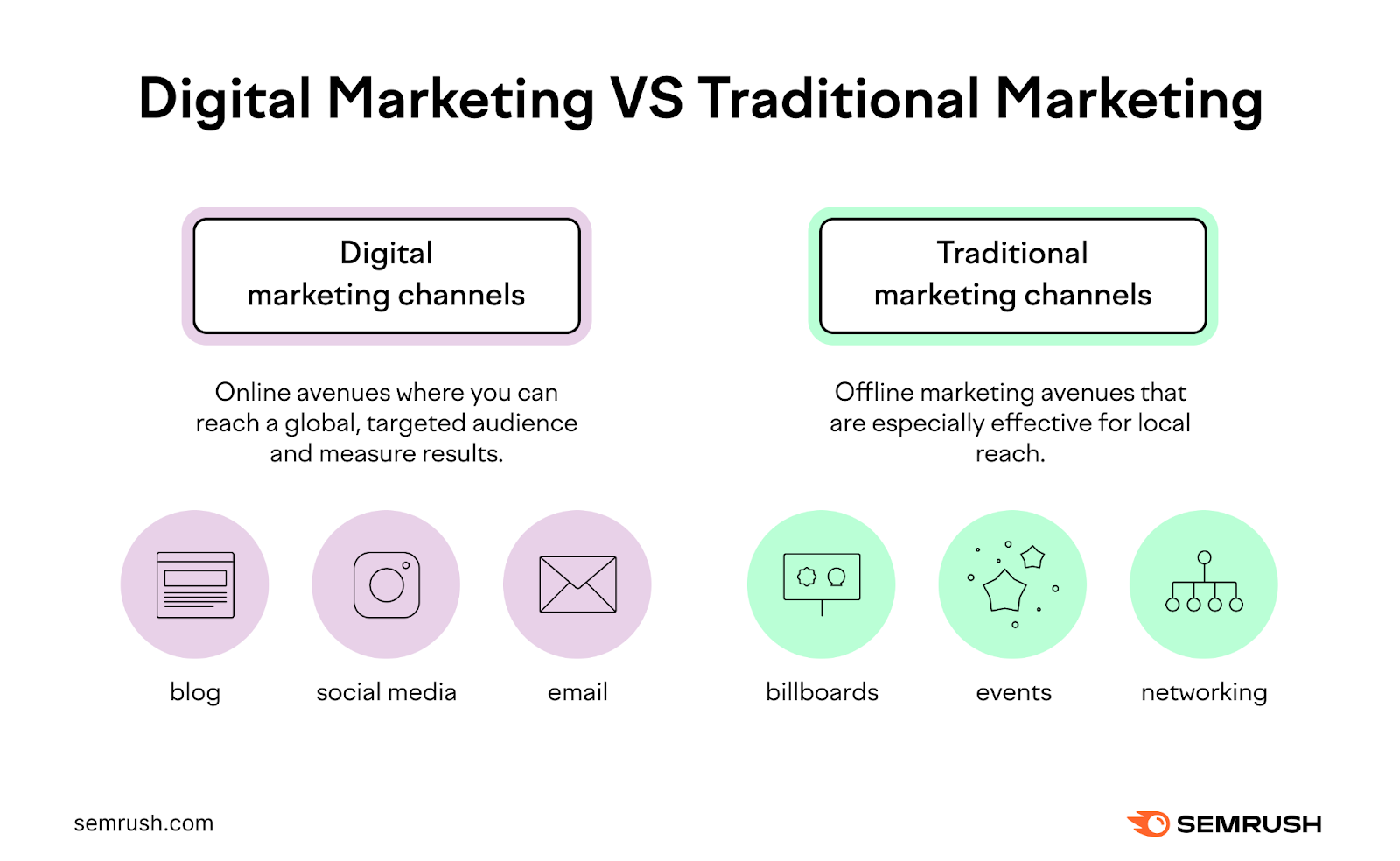
In this article, we’ll talk about the 12 most popular marketing channel examples to supercharge your online marketing efforts and engage with your target market.
1. Search Engine Optimization (SEO)
SEO is the process of improving your website pages’ ranking on search engine results pages (SERPs), like Google. Which can then increase your brand’s visibility and boost more traffic to your website.
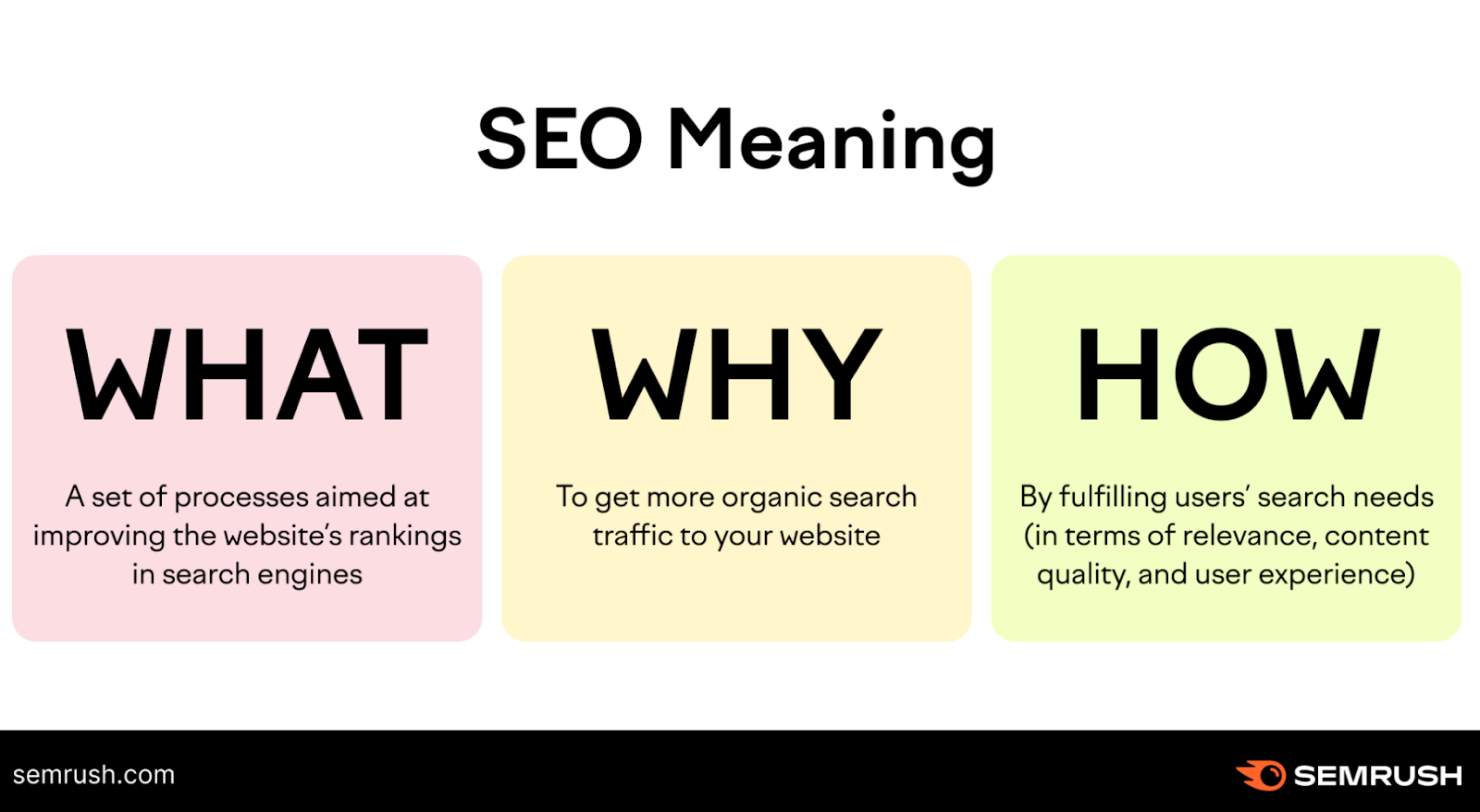
SEO can take time but can also provide major returns. In fact, organic search remains the top source of traffic for all websites, according to HubSpot data.
Ranking higher in search engines involves keyword research, content strategies, and content creation (among other activities).
But another part of SEO means creating a technically sound website so search engines can easily discover your web pages. So, you need an efficient site structure and must be vigilant in catching errors like broken links.
Semrush can help you do all that and properly leverage this marketing channel.
Here are two key tools in the Semrush suite to help you get started:
Discover the Right Keywords with the Keyword Magic Tool
Consistently creating high-quality content around topics relevant to your audience can significantly boost your search visibility, leading to increased website traffic.
You do that by finding the right keywords.
How?
With Semrush’s Keyword Magic Tool.
We designed it to help you find the most effective keywords for your content. With its database of over 25 billion keywords, Keyword Magic Tool offers a comprehensive analysis that includes:
- Search volume: How many people look for a keyword each month
- Keyword intent: What people who type in a keyword want to do—get an answer to a question, buy something, for example
- Keyword difficulty (KD): How hard that keyword is to rank for
- Cost per click (CPC): How much it would cost you every time someone clicks on your Google ad
- Number of results in SERP: How many pages already compete for that same keyword
To get started, type in your keyword, then hit “Search.”
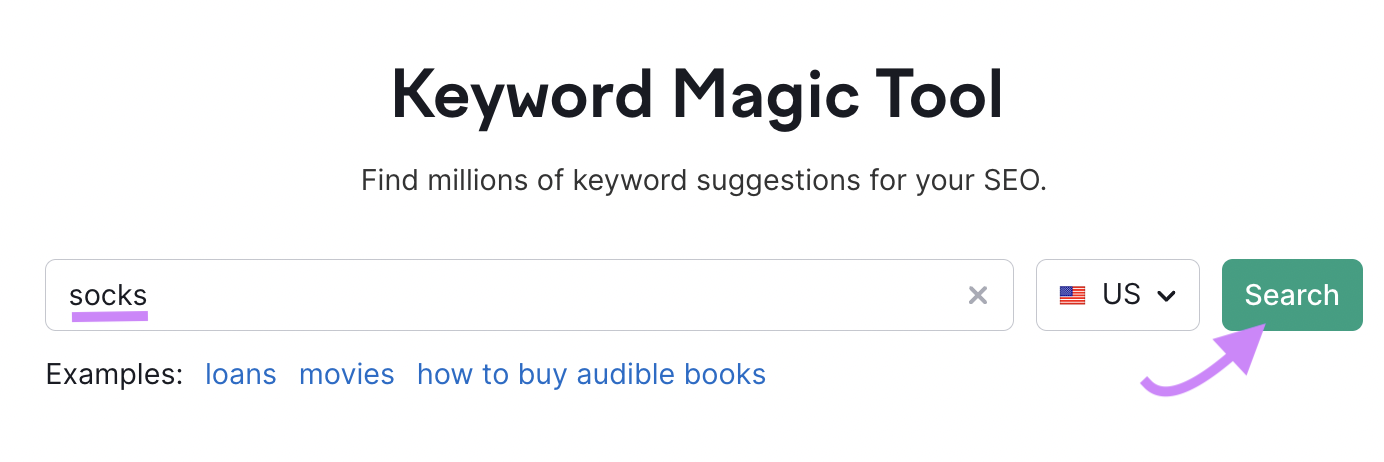
It returns a list of keywords that looks like this:
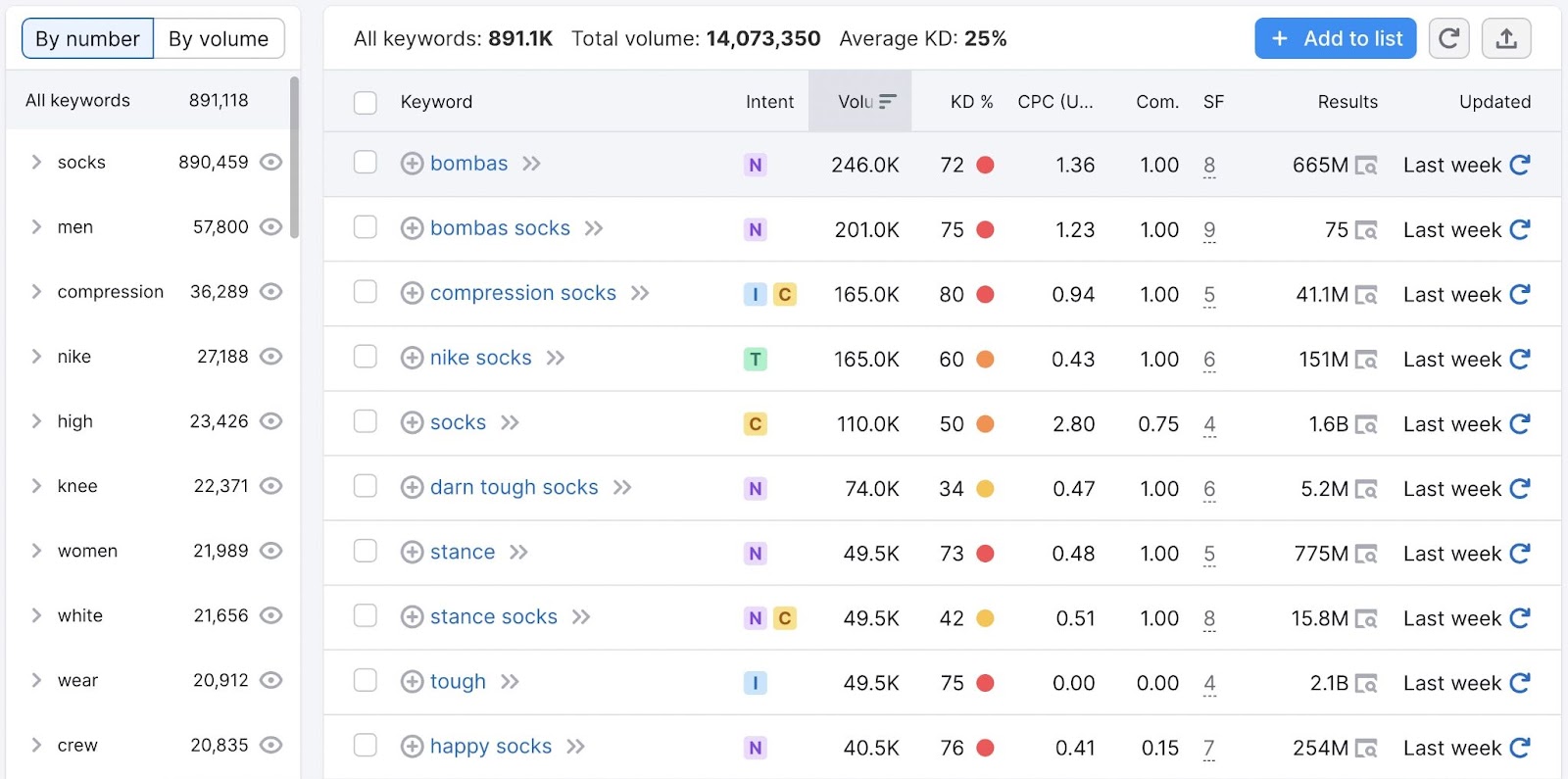
To narrow down your search, you can use the menu on the left. For example, if you click “men,” it will show you keywords related to men’s socks.

The Keyword Magic Tool can also help you further narrow down keyword lists, find related questions, and analyze why people searched for that particular keyword.
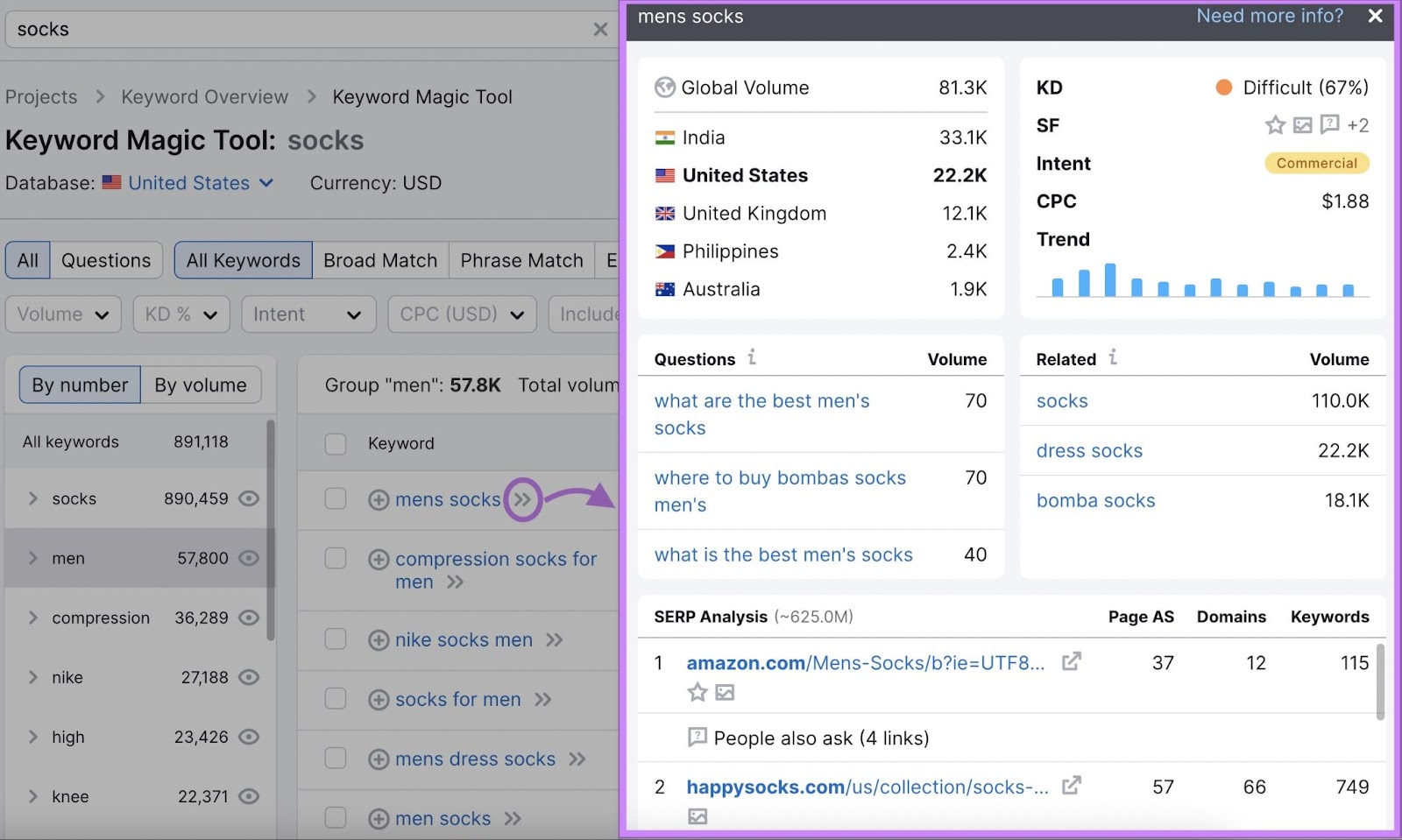
Using these features, you can choose keywords that resonate with your audience and give you an edge in the SERPs.
Further reading: How to Use Semrush for Keyword Research
Find and Fix Errors with the Site Audit Tool
For your content to rank well, it should be easy for search engines to find.
Our Site Audit tool is like a regular health check-up for your site.
Weekly audits will help you identify issues that may impact your SEO in a timely manner.
These could include broken links, duplicate content, slow page load times, missing meta descriptions, and more.
To test your site health, click “Create project,” type in your domain name, then give it a project name and hit “Create project.”
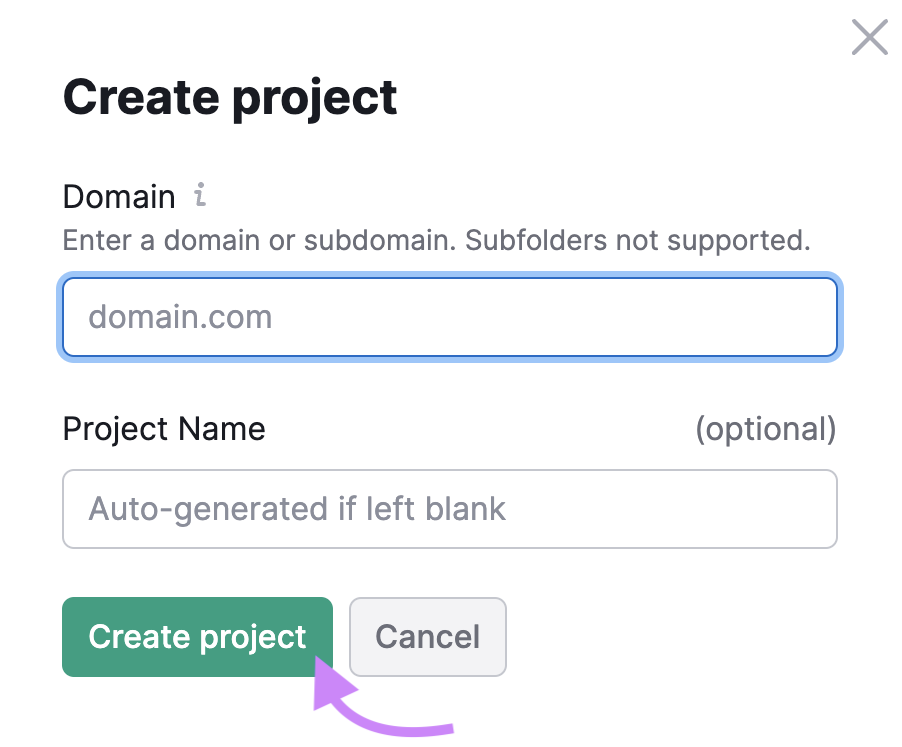
It then shows you information on your site health and gives it an overall percentage grade, also known as Site Health Score.
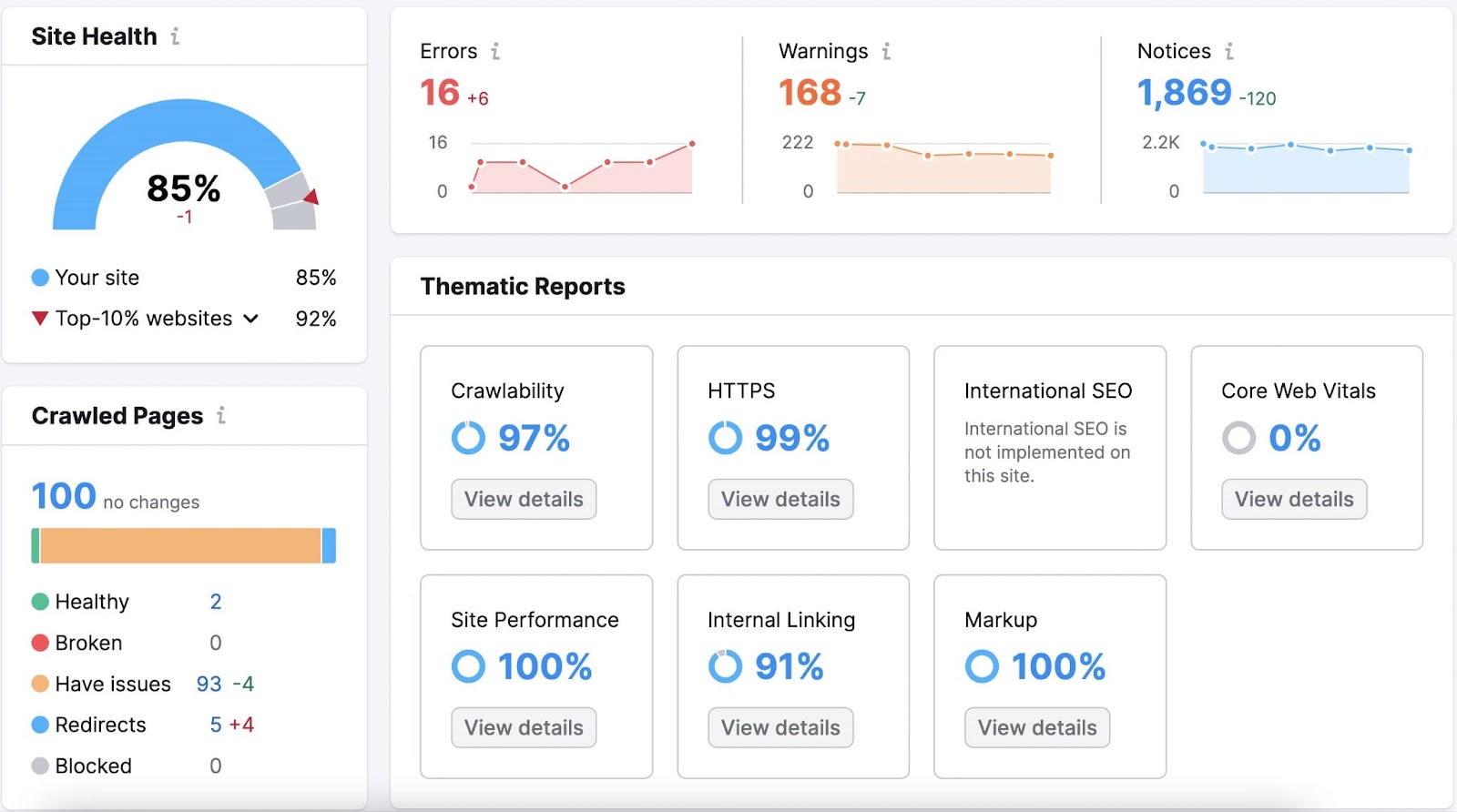
Errors should be fixed right away. These are issues of the highest severity.
Warnings are medium severity.
Notices aren’t issues, but they’re still worth fixing.
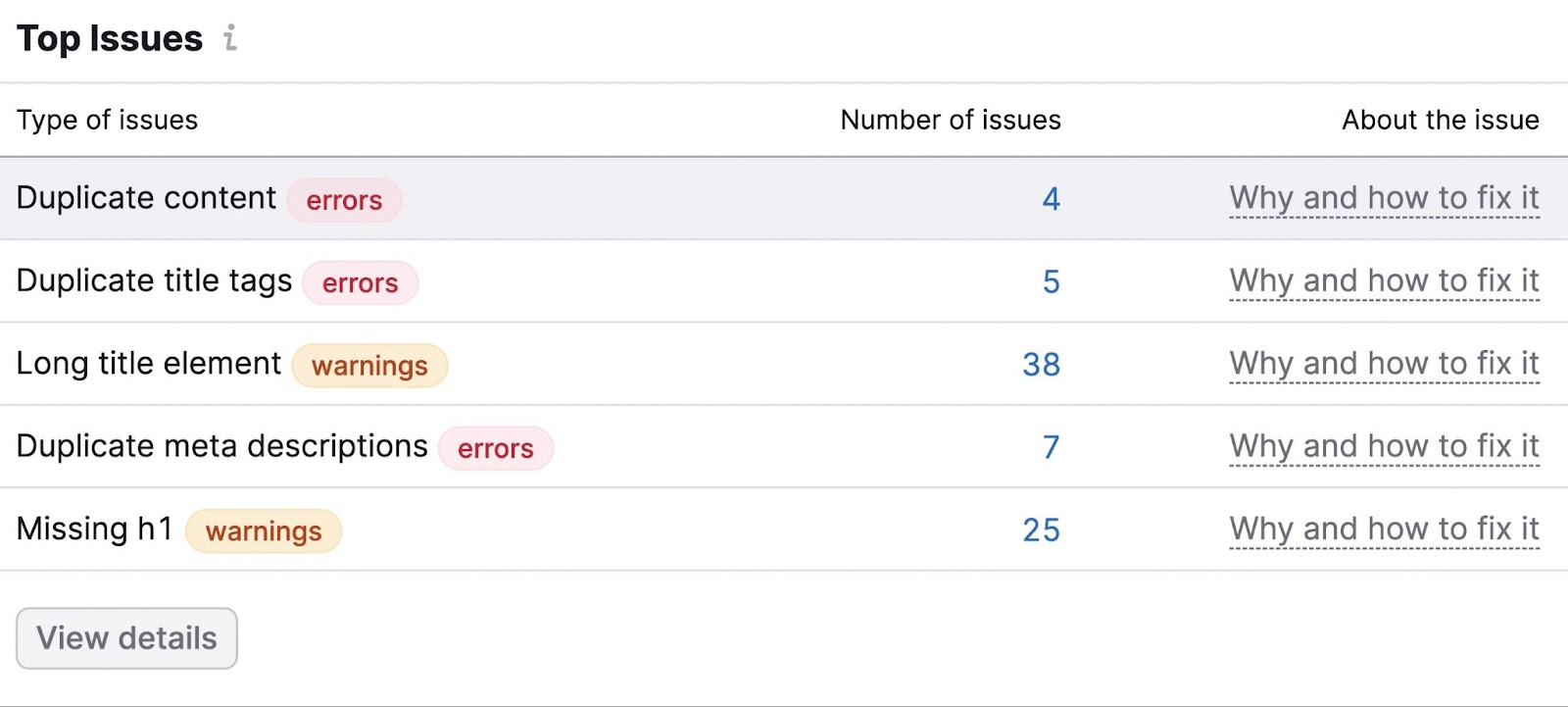
Addressing these issues as they arise helps you maintain a healthy website, which is crucial for climbing SERP rankings.
2. Content Marketing
Content marketing involves creating and distributing valuable and relevant content that attracts customers, builds your brand’s authority, and nurtures relationships.
Content can be a number of things like blogs, videos, infographics, and more.
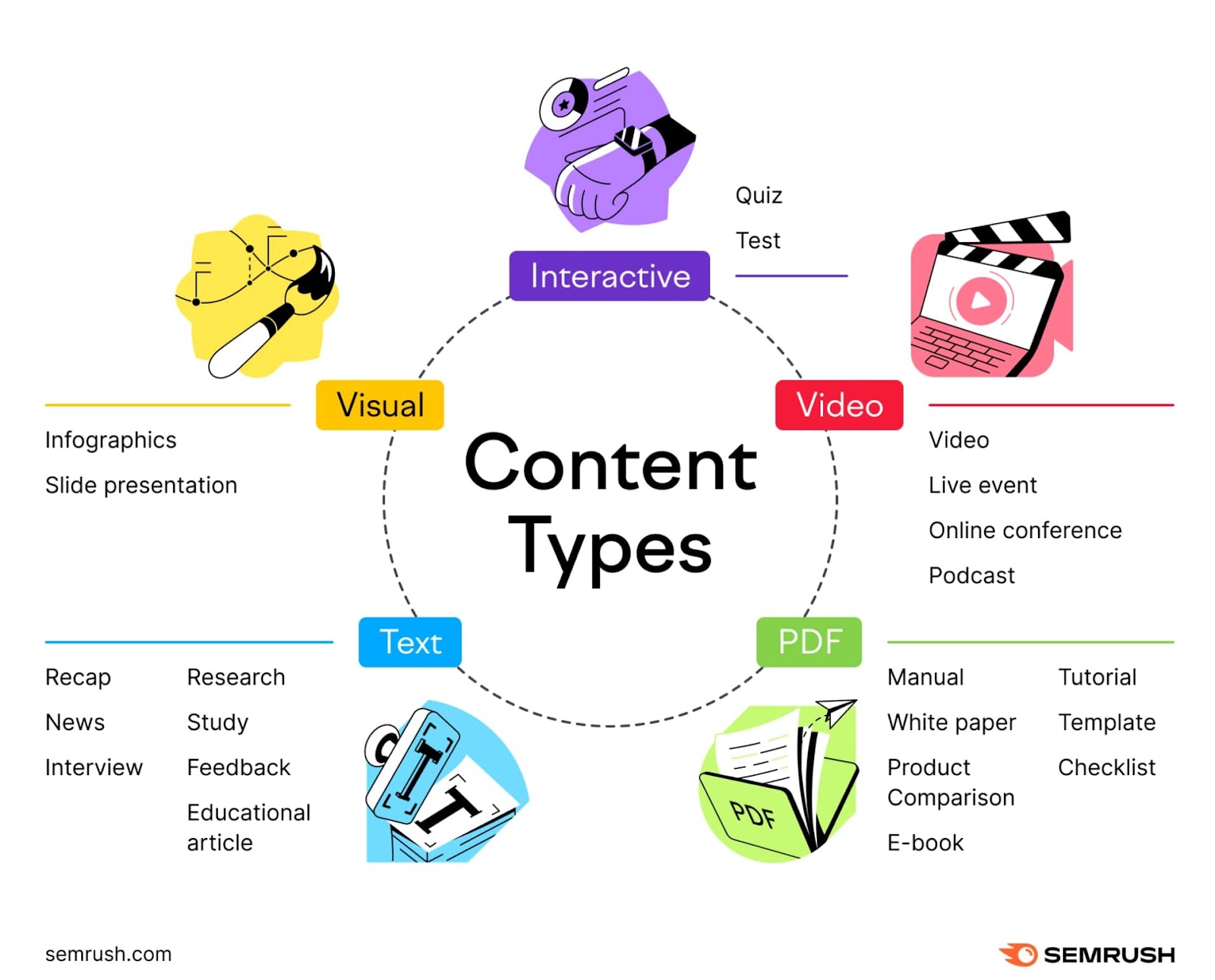
The aim of content marketing is to grow and engage your audience with useful resources and answers to their common questions. This also helps build trust and authority as they get to know your brand and content.
And the more they trust you, the more likely they want to do business with you.
For example, your content strategy might determine that your audience wants to know more about troubleshooting SEO.
So, you’d create articles, videos, and shareable graphics around that topic and share it on your blog.
Like Semrush did in our Advanced SEO category:
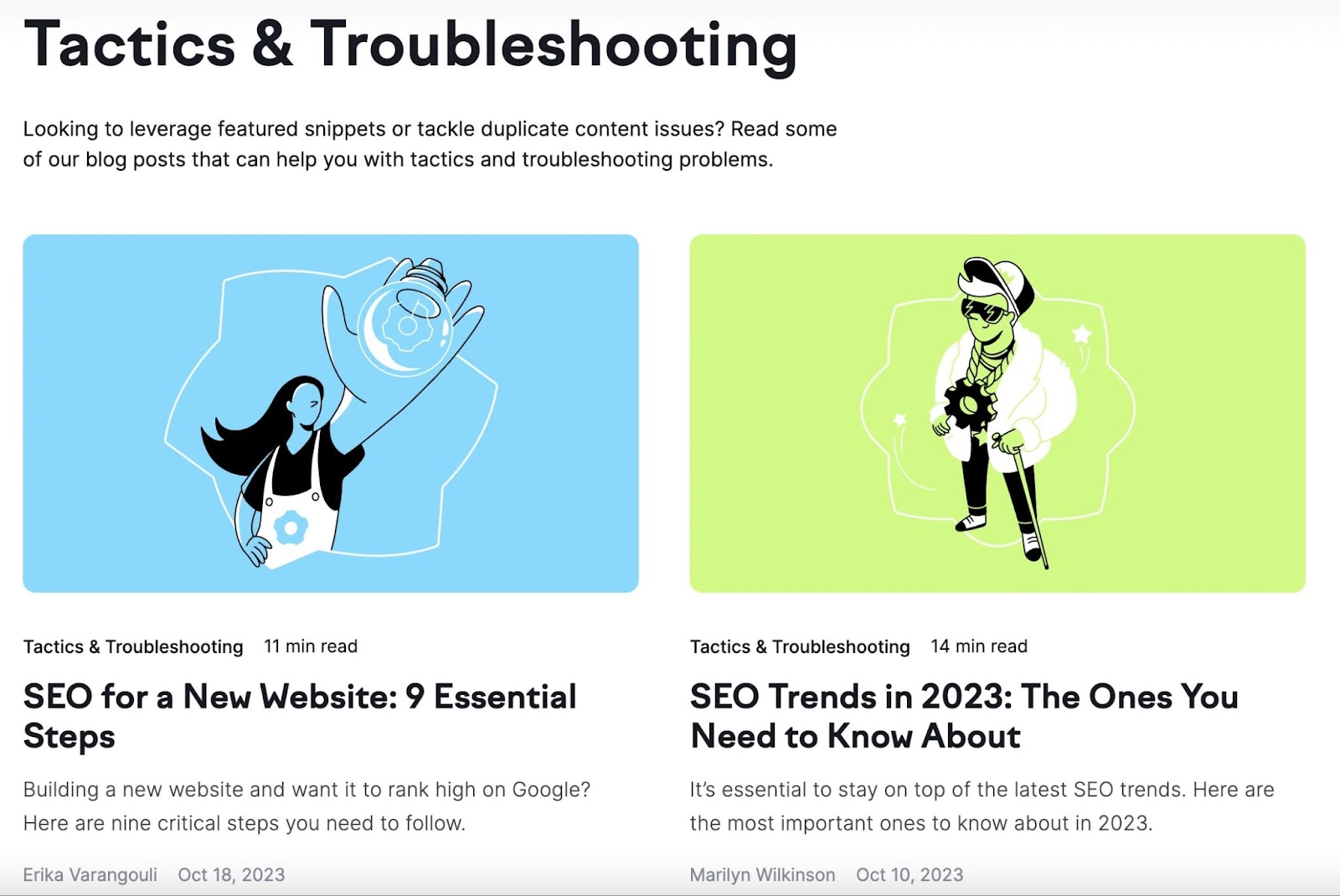
You can also repurpose your articles and share the highlights on social media and other channels.
Ideally, you want to both attract and engage your audience. It’s no good getting traffic to your blog if no one ever sticks around or clicks through to sign up for your newsletter (or whatever else your goal might be).
To encourage that to happen, you need a content strategy (a high-level plan for your content).
According to Semrush’s State of Content Marketing: Global Report, 80% of marketers who have a documented strategy are “very successful” in content marketing.
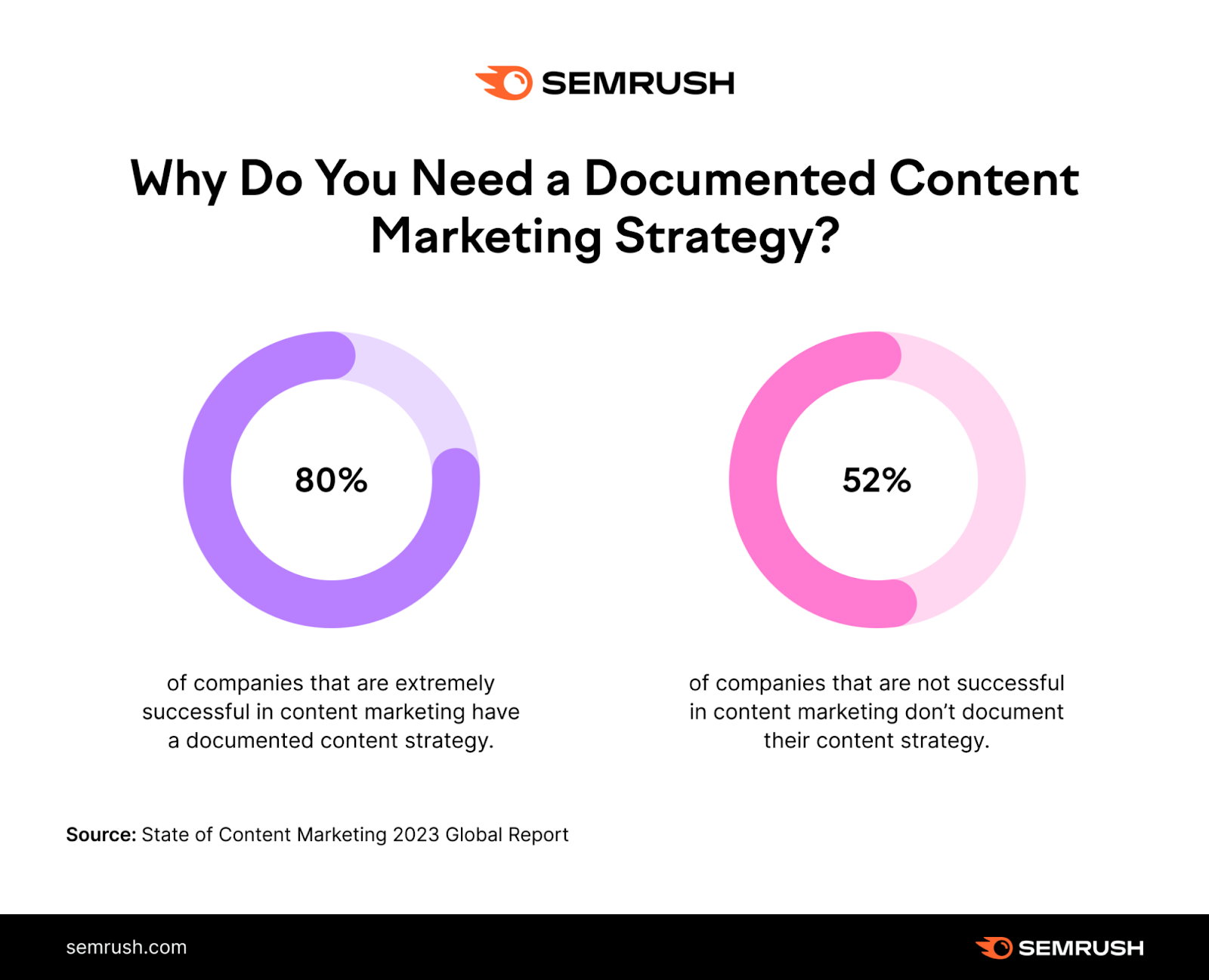
So, what should your strategy entail?
An effective strategy involves deep research into these five elements:
- Audience personas: Who does your content speak to?
- Brand story: Why do you want to create this content? How does it connect to your brand?
- Content marketing mission: What do you hope to help your audience achieve?
- Business case: How will this content drive the business forward?
- An action plan: What steps do you need to take to get there?
Further reading: You can learn more about content marketing strategies and the steps above in our guide: The Ultimate Guide to Content Marketing Strategy.
Social media marketing is the strategic use of platforms like Facebook, Instagram, LinkedIn, TikTok, and X (formerly Twitter) to promote a brand or connect with an audience.
With an estimated 4.95 billion people using social media platforms, it’s an essential channel for connecting with customers.
Social media is an effective way to reach your target audience, get instant feedback, run targeted ads, and even handle customer service issues in real time.
It’s like having a direct line to what your audience thinks and wants.
Say you’re a local coffee shop. You could use social media channels like Instagram and Facebook to:
- Promote your daily specials
- Showcase customer testimonials
- Share what happens behind the scenes (like in the kitchen)
- Announce updates on events like niche group meetups
All these social media activities can help you increase brand awareness, engage potential guests, and remind your new customers to visit you again.
For example, this Instagram post from Blue Bottle Coffee announced its new specialty coffee:

As you can see, Blue Bottle Coffee uses storytelling to announce new coffee on the menu.
It dives into the unique processing techniques and even introduces us to the family behind the beans, making the coffee more than just a beverage.
On one hand, social media offers real-time engagement with your customers. However, you need to consistently post quality content and interact with your audience, which can be time-consuming.
Organize Your Social Media Marketing
It’s easy to follow what others do on social media. But for the best results with your own audience, base your social media strategy on data-driven decisions.
That means determining which channels to utilize, analyzing competitors, tracking your past post performance, refining your target audience, etc.
Luckily, you can do all of this (and more) with Semrush’s Social Media Toolkit.
For instance, you can see competitors’ top posts and filter by what gets the most engagement:
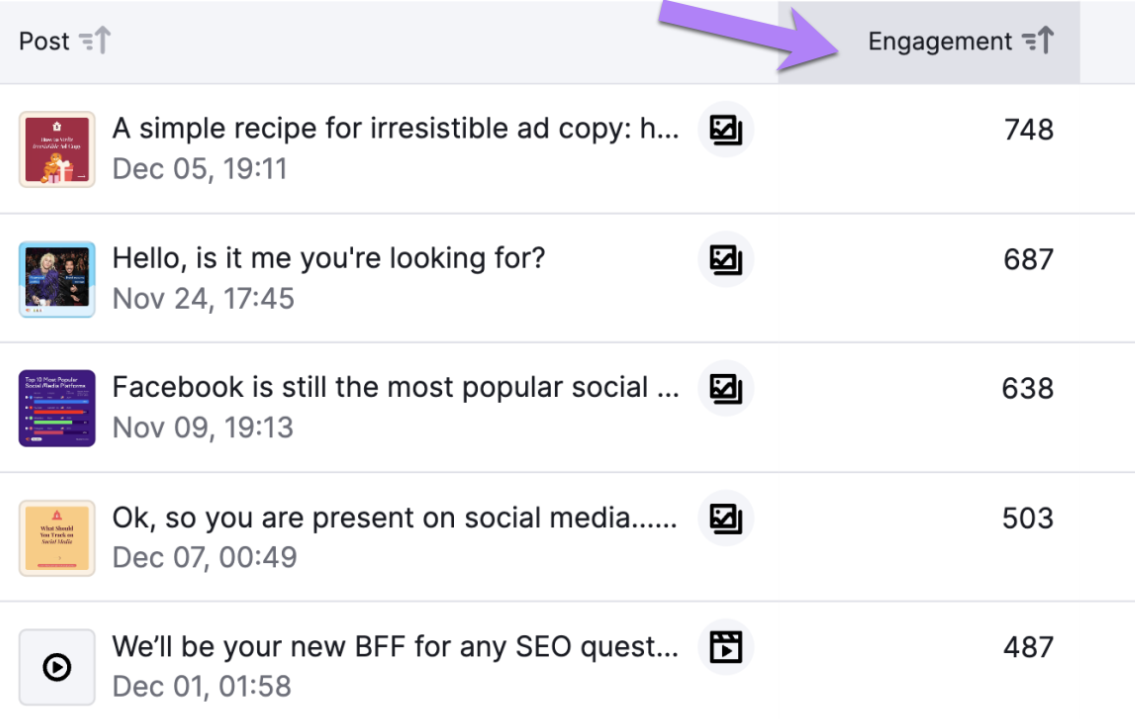
This information can inspire your social media ideas. Helping you create posts that are more likely to resonate with your audience, increase your reach, and improve customer relationships.
And eventually, get you more sales.
You can also get daily analytics reports in your inbox. And schedule and organize social posts across various platforms:
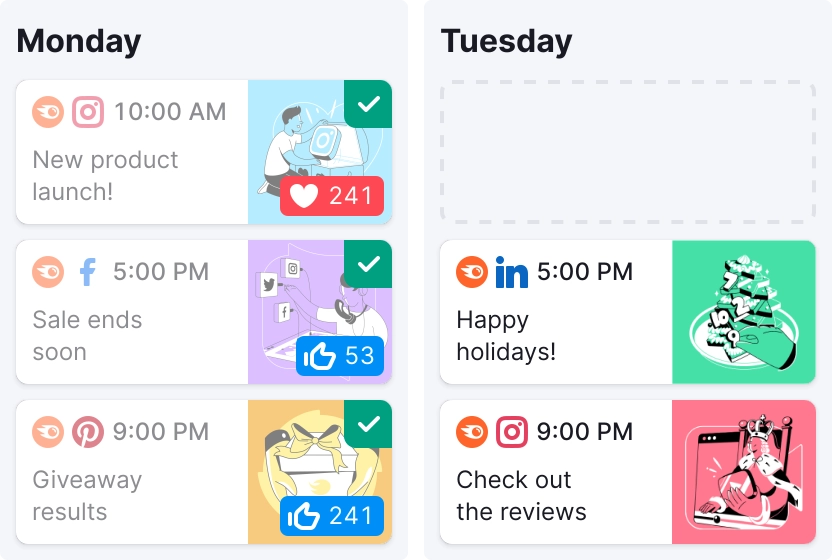
One of the most time-consuming parts of social media management is replying to messages to stay on top of your customer queries.
Semrush’s Social Media suite even includes a Social Inbox where you can reply from one dashboard. Saving you time in your social media inboxes.
4. Email Marketing
Email marketing involves sending targeted messages to email list subscribers to drive engagement, sales, or other desired actions.
In 2023, email marketing generated 10.89 billion dollars in revenue.
Plus, email marketing delivers a return on investment (ROI) of $36 for every dollar spent, making it indispensable for any serious online marketing strategy.
You’ll have different goals to tailor each of your emails to.
Some may advertise a product or encourage users to re-engage with your brand. Like this one from the soda brand OLIPOP:
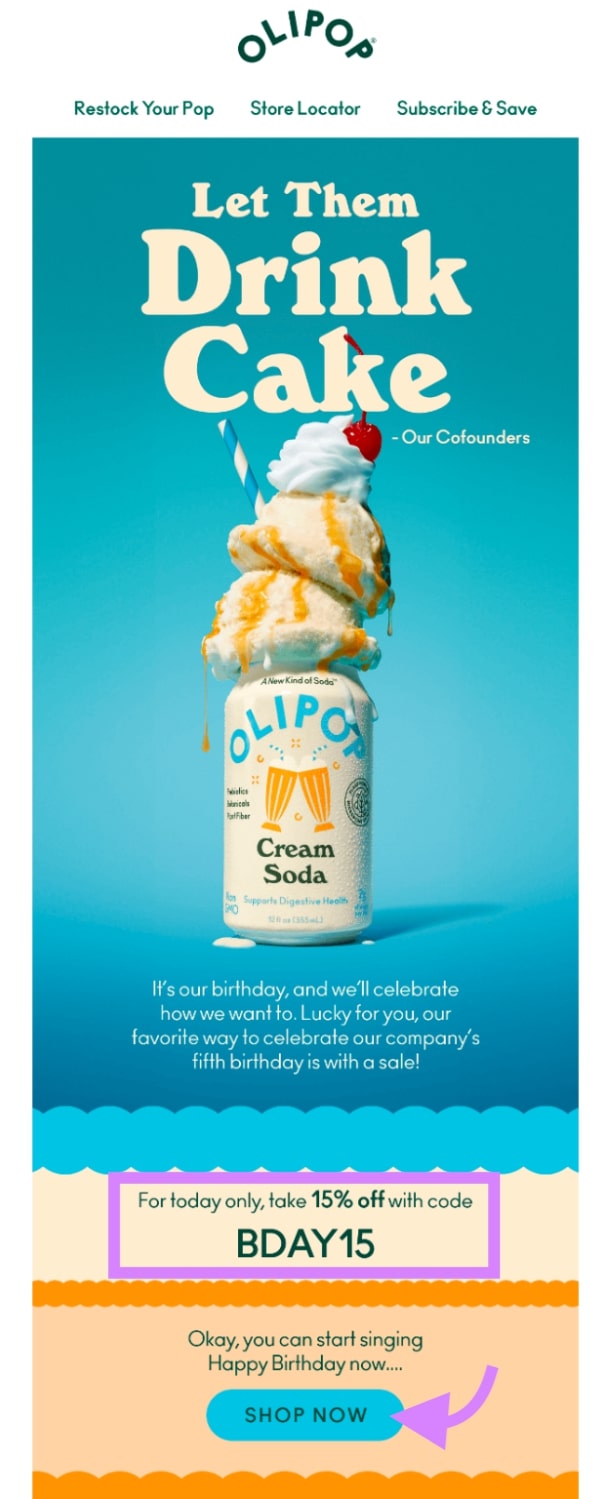
Image Source: Really Good Emails
It offers a discount code to celebrate the company’s birthday, inviting readers to “Shop Now.”
This type of email is a great way to reconnect with your customers and remind them you exist when they’re not actively looking for you.
Other emails may intend to build relationships with engaging content. Like newsletters and fun emails, including this one from The Sill:

Image Source: Really Good Emails
This email uses a flow chart leading to a plant product category. A clever and inviting way to help customers enjoy your brand and build connections.
Email marketing is affordable, accessible, and effective across the marketing funnel. You can use it to increase brand awareness, nurture customers in the consideration stage, and encourage them to buy—all with an email.
Set up Your Email Marketing
To leverage this channel, you need email addresses. To build that list, you should provide valuable content in exchange, like an interesting newsletter, a webinar, or an informative industry report.
Here are the steps for getting started with email marketing:
- Build your mailing list: Offer exciting content that people will trade their emails for (e.g., an insightful newsletter). Be sure to let people know what they can expect in their inbox by signing up, such as email type (e.g., promotions, new product announcements) and frequency.
- Choose a service provider: Use a dedicated email service provider (ESP) to monitor analytics and improve your email marketing. Some of the top providers include Mailchimp, ActiveCampaign, and Constant Contact.
- Create a marketing plan: Create emails based on your goals and send them to the most relevant audience segments. A general newsletter might go out to everyone, but a product email might only go to groups who’ve shown interest.
- Design your emails: More than ever, emails can be visually pleasing and connected to your brand. Learn the best email design practices for the biggest impact.
- Test your email systems: It’s easy to get carried away with design or to write copy that triggers SPAM bots. Test your email by setting up test inboxes on different devices and servers.
- Use email automation: Automate what you can to streamline the process. Depending on your ESP, you can schedule emails, automate segmentation, and send transactional emails automatically (e.g., abandoned cart and order confirmations).
Further reading: Learn more about executing the steps above in our guide: How to Get Started with Email Marketing in 6 Easy Steps
5. Paid Advertising
Paid advertising involves buying ad space on platforms like search engines, social media, and websites. Paying every time someone clicks your ad is called pay-per-click (PPC).
With a well-crafted campaign, paid ads can offer immediate visibility and quick results, making it a key player in any comprehensive digital marketing plan.
For example, if you search for “best puppy food,” you’ll see sponsored results from various pet food brands at the top of the search page.
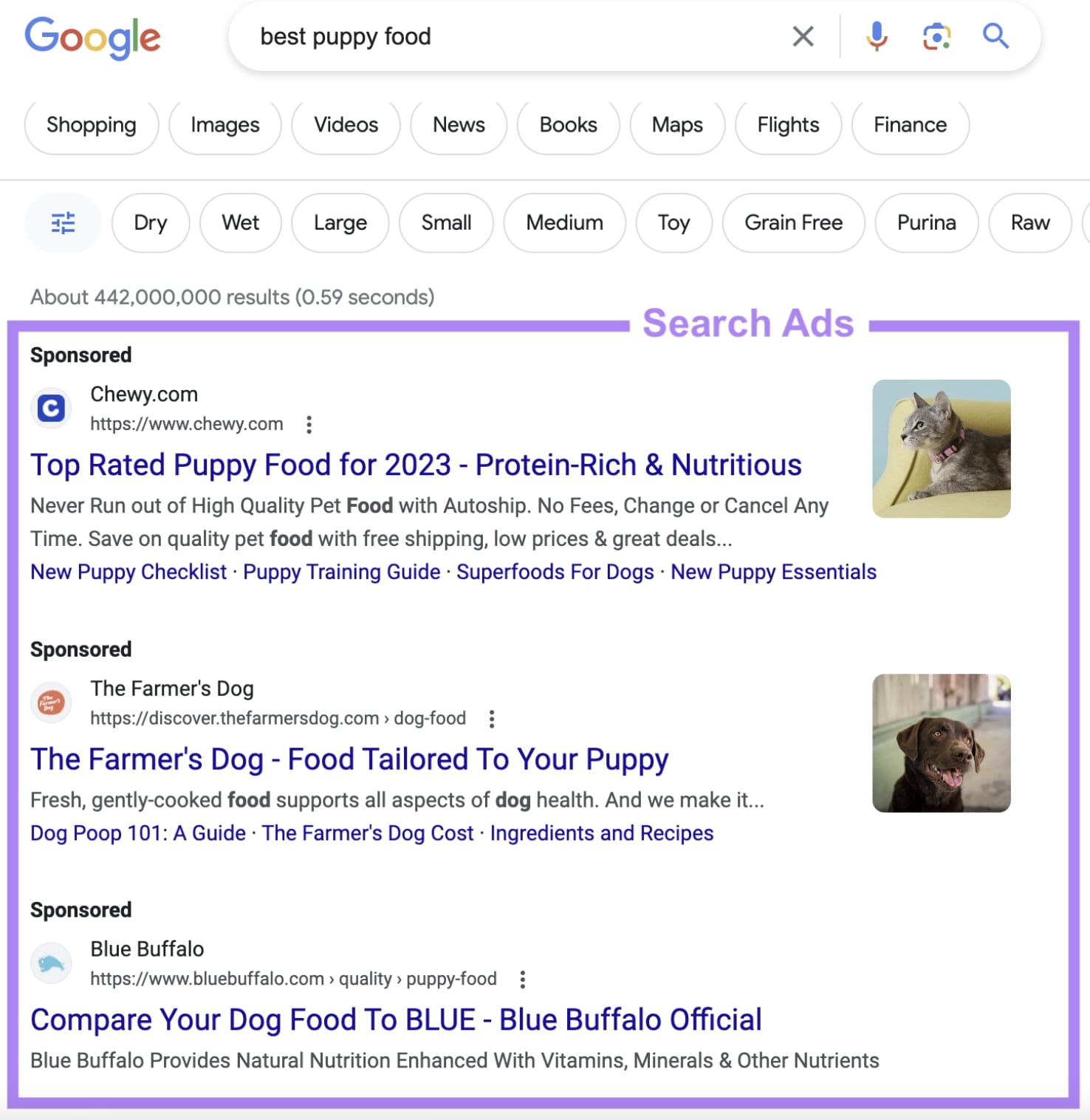
All these companies have used Google Ads to bid on the keyword “best puppy food” and get the sponsored place at the top of the SERP.
PPC excels in providing quick, measurable results.
You can see traffic—and possibly conversions—almost as soon as your campaign goes live. It’s highly customizable, allowing you to target by age, location, and even behavior.
However, it requires excellent budget management to ensure you get the most out of your investment.
How to Create Effective Paid Ads
To put your ads in front of your target audience as quickly as possible, follow these four steps:
- Define your budget: How much do you have to spend? Adjust this based on ad performance and business objectives.
- Plan your campaign: Define your primary goal (brand awareness, leads, etc.) based on your target audience’s needs. Decide what ad platform and type you’ll use for your campaign.
- Create your ads: Write a clear, compelling message that uses high-quality visuals and includes a call to action (CTA)
- Apply settings and targeting: Use targeting options to help you reach the right people, then adjust your settings like budget, bidding, schedule, and placement to get the most from your campaign
You can make your PPC campaigns more effective with tools. Like Semrush’s Advertising Research tool.
Get a behind-the-scenes peek at your competitor’s PPC activities, ad spend, and most successful ad copy.
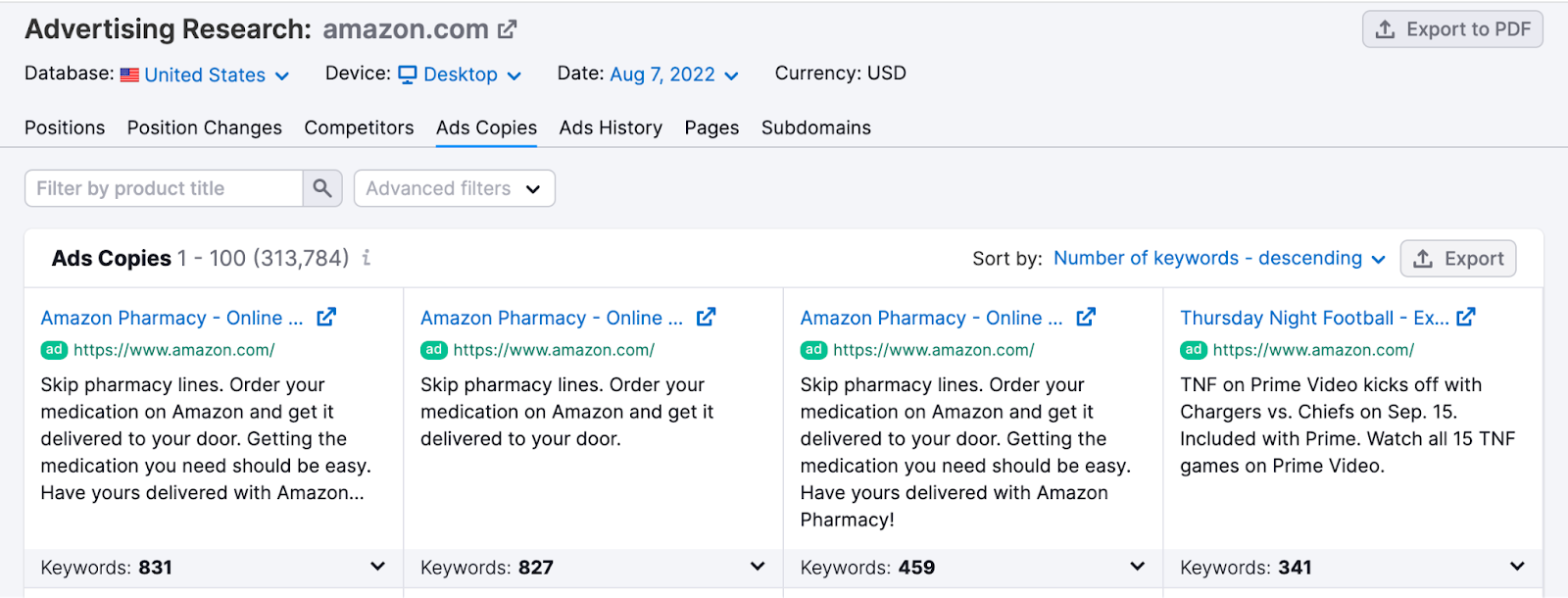
You can also use the PPC Keyword Tool to improve your ads.
The “Recommendations” function can help you streamline your campaign. It can help you plan and organize your keywords at both the campaign and ad group level while easily setting negative keywords.

The PPC Keyword tool helps you identify the best keywords, manage your ad groups, and even gives you a cost estimate, streamlining your paid advertising efforts.
Further reading: Learn more about online advertising in our guide: Online Advertising: All You Need to Know (2023 Updated)
6. Video Marketing
Video marketing involves creating and sharing videos on platforms like YouTube, social media, and your website to promote your brand, products, or services.
Our State of Content Marketing: 2023 Global Report found that video is on everyone’s minds, and it’s the top performer across content formats.
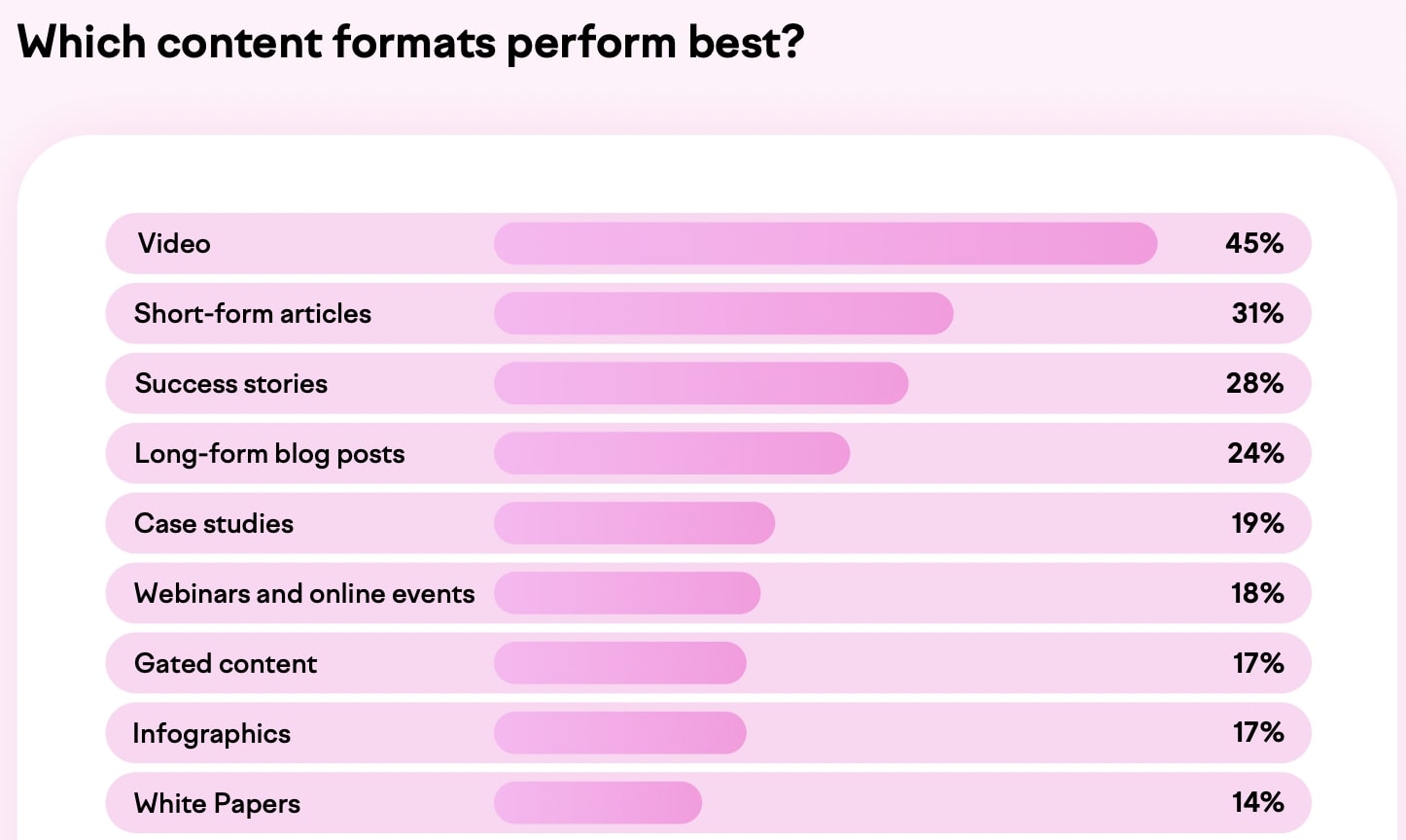
It’s an important marketing channel because video offers dynamic, engaging storytelling.
Videos grab attention, simplify complex topics, and evoke emotions, boosting engagement and conversions across platforms.
For example, this video from Apple effectively combines brand storytelling with corporate responsibility.
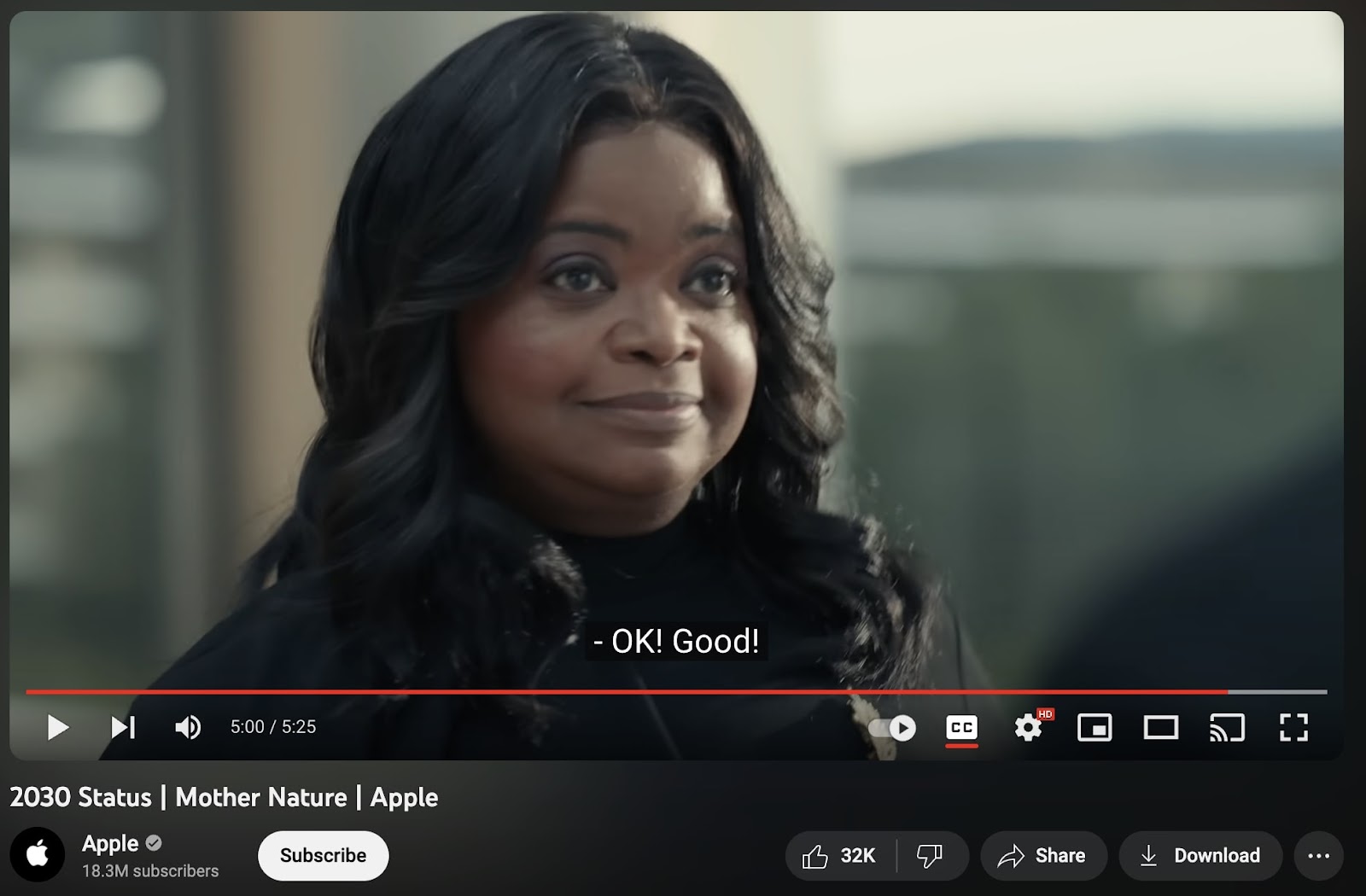
The video engages sustainability-conscious viewers and boosts brand trust.
While video marketing excels in brand storytelling and engagement, high-quality video production can be costly and time-consuming.
So, if you’re new to video marketing, start with bite-sized content. Use analytics tools, like the ones built into YouTube or Vimeo, to measure viewer engagement and fine-tune your strategy based on the data.
Getting Your Videos to Rank
You’ve created the perfect video for your audience. Now, you need to ensure they see it so all your effort doesn’t go to waste.
One of the ways to help your video rank involves using every opportunity available to add keywords and appear relevant to the viewer.
Here are the top ways to help your video rank in a search engine, whether it’s Google, YouTube, or TikTok:
- Create eye-catching video thumbnails and covers: Many people choose to click on your video based on its thumbnail image. Be sure the image relates closely to your video topic.
- Relate your title tag or cover text closely to the video: Titles are important for search intent. Use well-researched keywords in your title to attract the right audience.
- Add a video description: Use this the same way you would a meta description. Include relevant keywords and, where possible, a call to action.
- Tag your video: Tags help you categorize your videos. They also help users find related videos. These can be tags you set when creating the video, like on YouTube. Other times, they’re hashtags, like on Instagram Reels.
- Upload a transcript if captions are not automated: Add copy to your video that search engines can crawl. TikTok and Instagram auto-generate captions (if you turn them on), but other sites may need an uploaded transcript.
Further reading: Learn more about the steps above in our guide: Video SEO: How to Get Your Videos to Rank
7. Influencer Marketing
Influencer marketing involves collaborating with individuals who have a strong social media following to promote your brand.
This marketing channel leverages the influencer’s trust and audience engagement, amplifying your reach to potential customers.
Influencer marketing also lends some of that influencer’s brand trust to you, meaning their audience may take less convincing to trust you and spend their money with you.
Here’s an example of an influencer, Ellen Brocky, advertising cat food to her Instagram audience of over 125k followers to raise Pro Plan’s brand awareness:
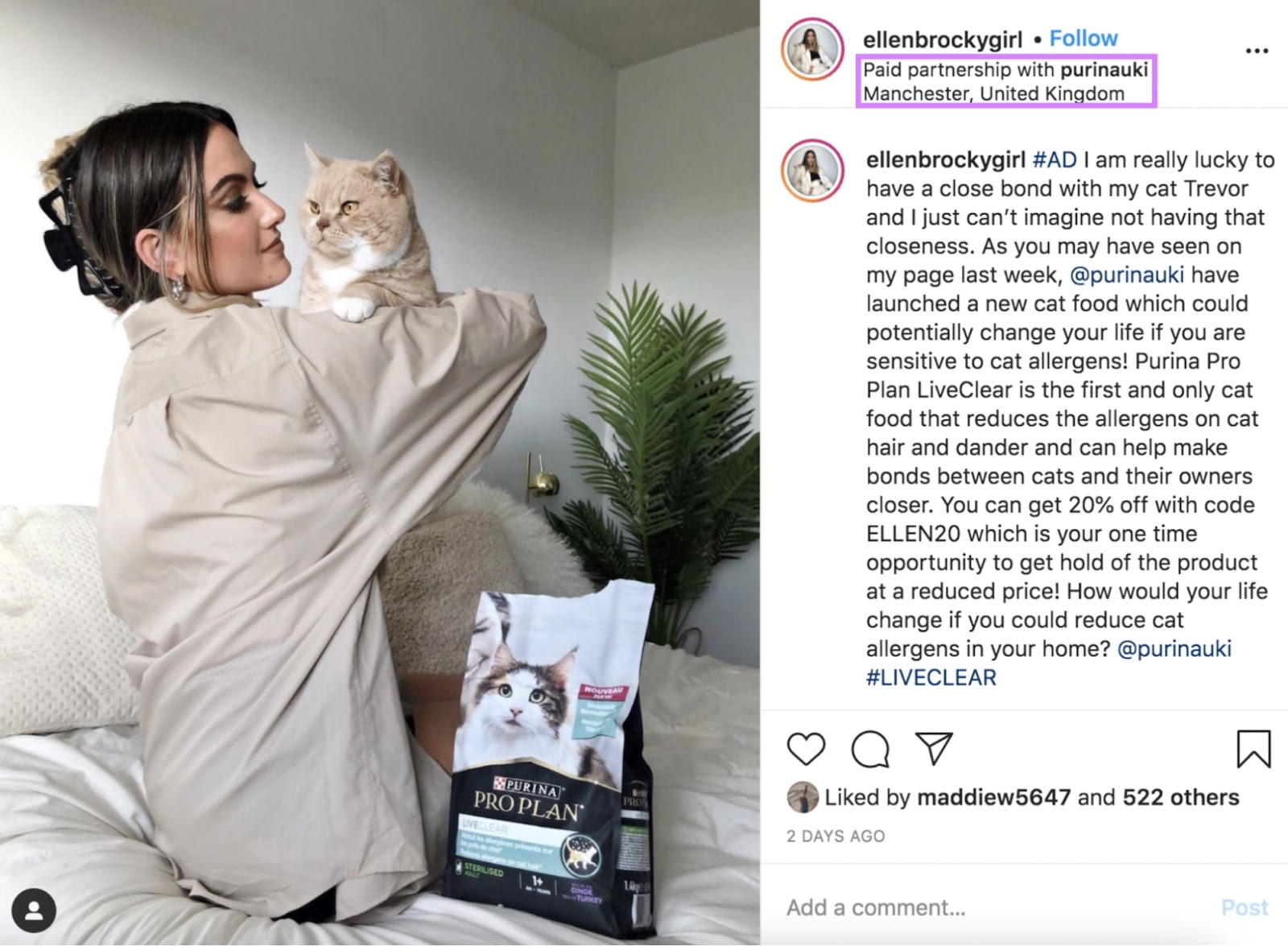
Influencer marketing can be an effective tool to grow your audience regardless of your business size or industry. Here’s how to make it work for you:
Tips for Marketing With Influencers
Influencer marketing can offer high engagement rates and tap into audiences you might not reach otherwise.
However, choosing the right influencer whose values and audience align with your brand is crucial, or else the campaign could backfire.
Follow these tips for an effective campaign:
- Set goals: What do you want to achieve with your influencer marketing?
- Define your audience: What audience do you want to tap into?
- Determine your campaign messaging and the brief: Whatever your goals are, make them clear in your brief so the influencer knows what they need to do
- Set a budget: How much do you have to spend? Per campaign, per influencer, etc.?
- Find influencers: Who do you want to work with? Research influencers in and around your industry.
- Track campaign performance: What results have you received from your influencer marketing? Brand awareness, increased sales, etc.
To make the process easier, check out Influencer Analytics by Semrush.
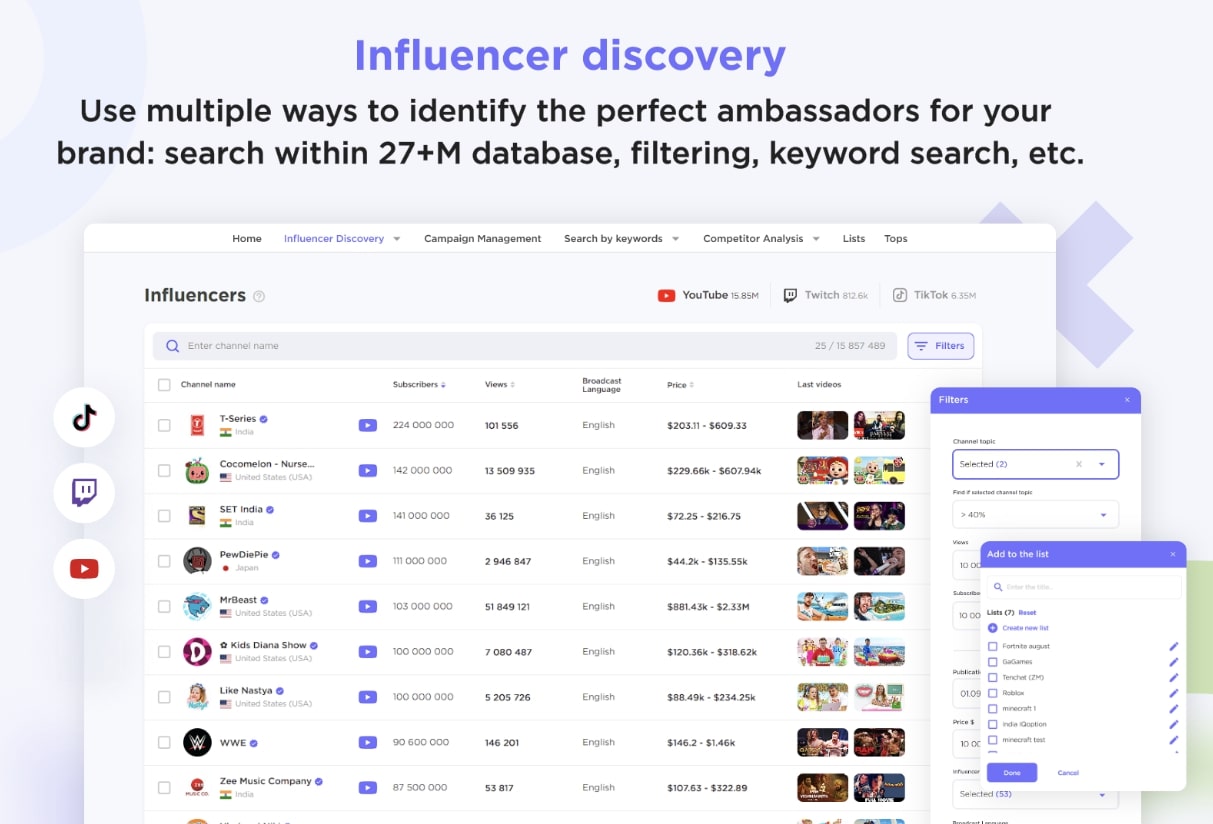
This platform helps you identify the right influencers for your brand, track campaign performance, and manage payments, streamlining the process and making it more effective.
Further reading: Influencer Marketing: What Is It and How to Build a Solid Strategy
8. Affiliate Marketing
Affiliate marketing involves partnering with other businesses or individuals to promote your products in exchange for a commission on sales.
This channel can extend your reach and drive sales without the upfront costs of traditional advertising.
The affiliate marketing industry is huge. It’s currently worth $20 billion and is expected to almost double by 2031.
Amazon’s Affiliate Program is a prime example.
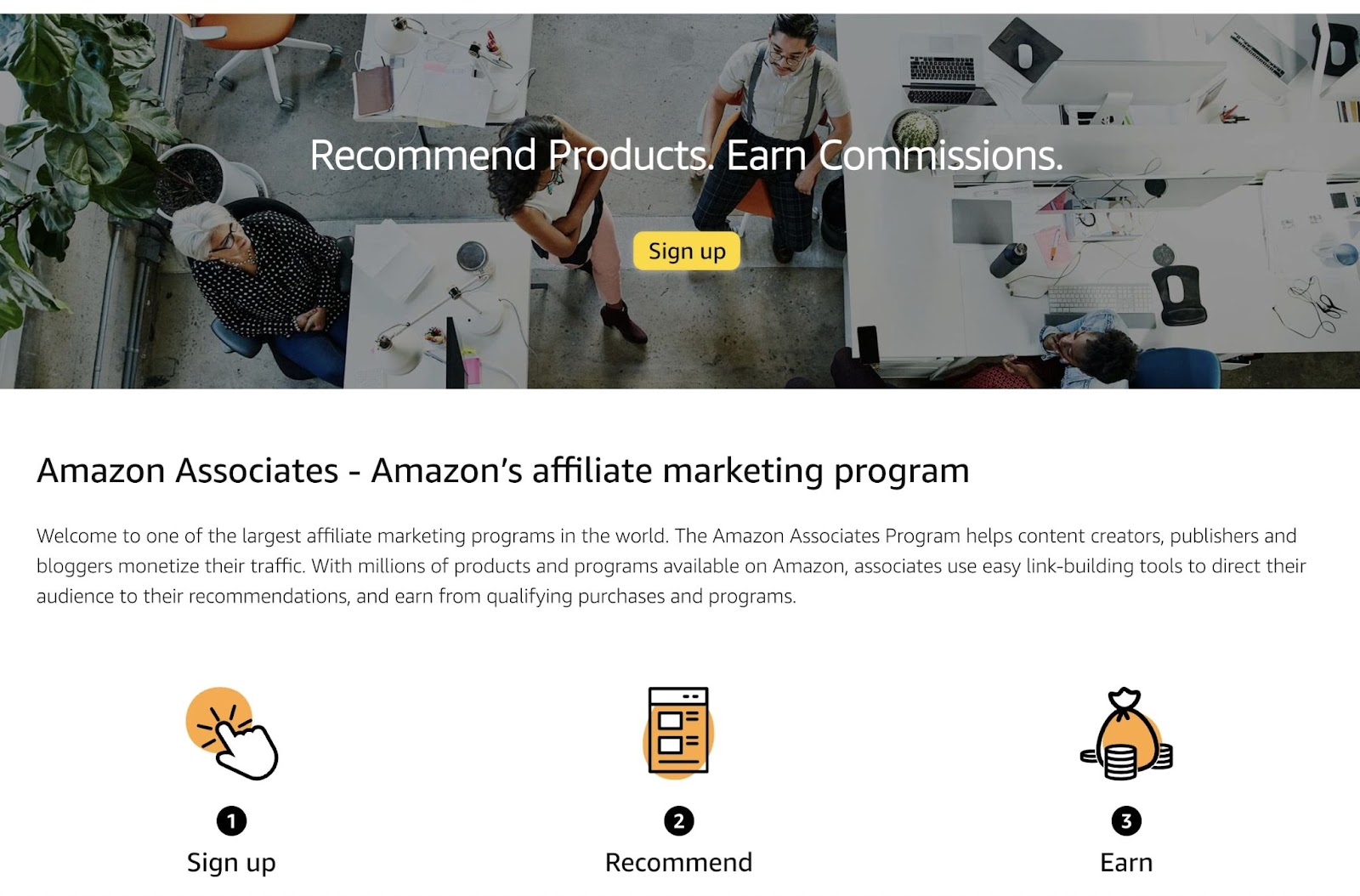
Bloggers and website owners can earn commissions when they promote Amazon products. When someone clicks their referral link and makes a purchase, the affiliate earns a percentage of the sale.
Affiliate marketing offers a cost-effective avenue for boosting sales and expanding your brand’s visibility. It’s a pay-for-performance model, meaning you only give out commissions when actual sales occur.
However, it’s not without its challenges.
You’ll need to meticulously manage your affiliate partnerships to maintain brand integrity and monitor for fraudulent activities like click spamming or fake conversions.
Setting up an Affiliate Program
To get started with an affiliate program, follow these four steps:
- Choose a niche: Consider what industry/audience you want to target
- Find affiliate networks or schemes to use: Networks such as Partnerize offer a middle ground between brands and their affiliates. But you can also manage affiliates yourself.
- Choosing products to promote: Decide what product or service you’ll promote with an affiliate program
- Plan a strategy to promote these products: Choose how you’ll promote your affiliate scheme. How will those who sign up promote your product/service?
Further reading: Learn more about affiliate marketing in our guide: What Is Affiliate Marketing: How to Start in 4 Easy Steps
9. Podcasts
Podcasting is a form of content marketing that involves creating audio content for streaming.
This channel offers a unique avenue to connect with your audience personally, often leading to increased engagement and trust.
The “How I Built This” podcast by NPR is an excellent case study on this:

It features interviews with entrepreneurs and business leaders, offering valuable insights while also subtly promoting NPR’s brand and other content.
Podcasts excel in building deep connections with your audience and position your brand as a thought leader.
It’s also a marketing channel that people can consume while multitasking (like driving or cooking).
Since many people often listen via headphones or earphones, podcasts can often feel more personal, too. Helping deepen their bond with your brand.
However, high-quality podcasts demand professional equipment and editing.
Hosting Your Podcast
You can host your podcast on Spotify, Apple’s Podcasts app, and more. But how will you track its performance across these platforms?
Check out Semrush’s Podcast Hosting tool.
You get unique listener reports and distribution everywhere via RSS.
The tool can also transcribe your podcast to help you get those SEO benefits and even convert it into video for extra exposure.
Plus, you get in-depth analytics to measure listener engagement and episode downloads.
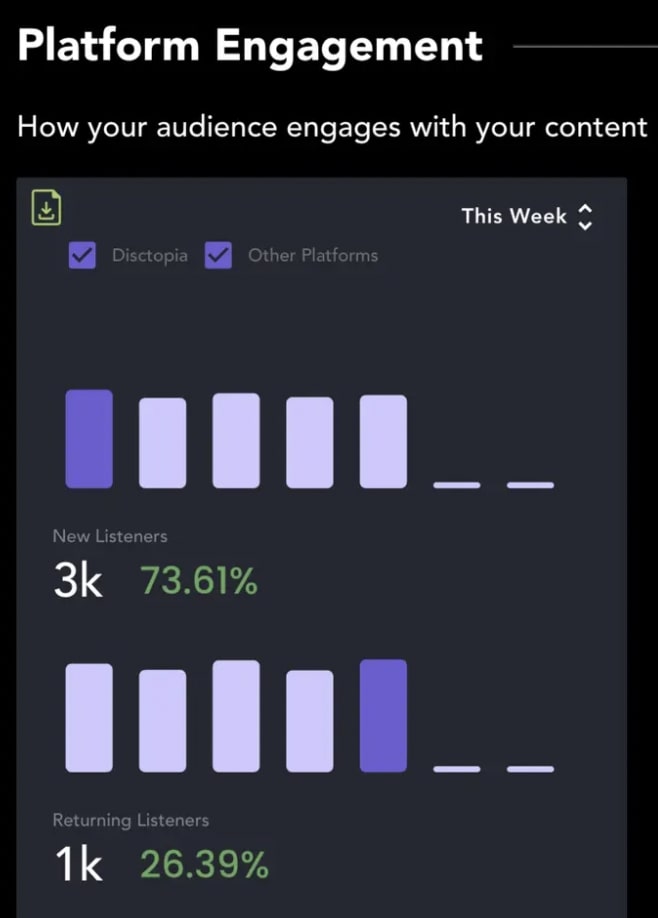
Further reading: 69 Podcast Statistics to Boost Your Podcast Strategy
10. Digital PR
Digital public relations (PR) is the practice of managing a brand’s online reputation and visibility through strategic communications.
It helps brands gain a competitive advantage through link building—and backlinks are a known Google ranking factor.
It’s even had the official nod from Google’s John Muller:
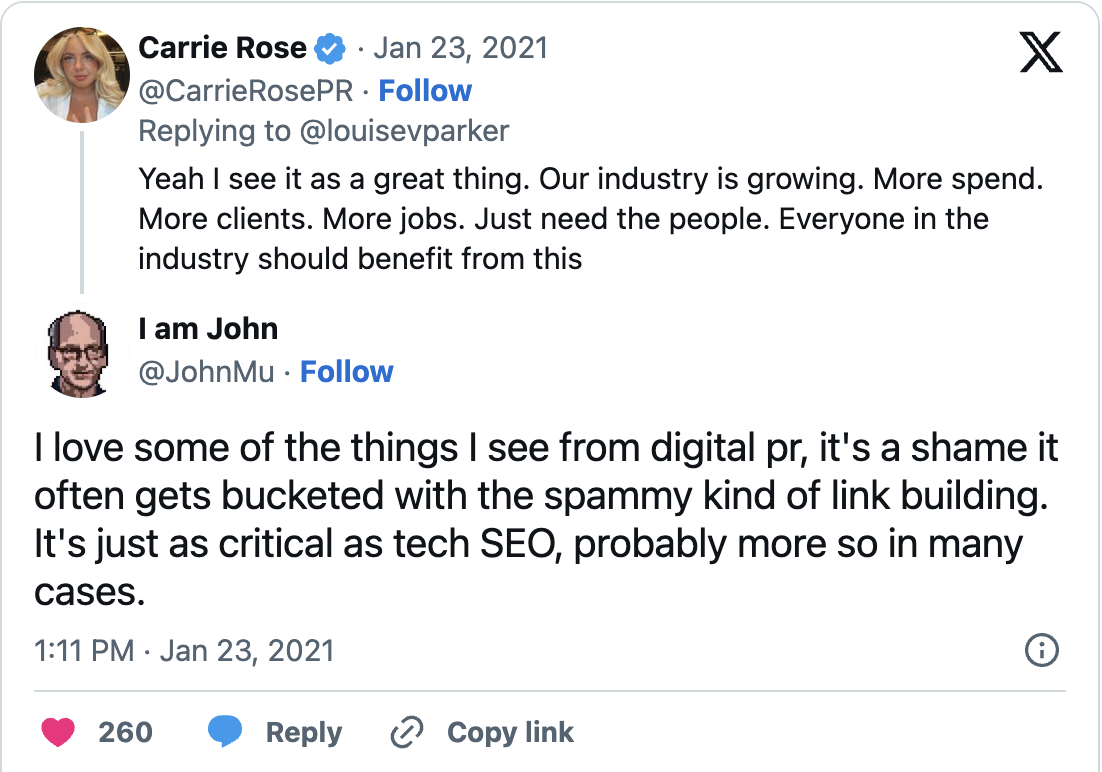
Digital PR is an extension of traditional PR, but it focuses on digital platforms like social mediaapps, blogs, and online publications.
The goal is to use traditional PR strategies to reach more people. You may get extra links back to your website from this, but it’s not the primary goal.
It’s ultimately about building relationships with online communities, journalists, and influencers to amplify your message.
And there are many ways to do that. For example, you could:
- Write an article about an influencer in the space and tag or send it to them
- Interview a thought leader and harness their audience when they share the interview with their followers
- Guest blog or appear in a community panel post where you contribute your thoughts on a particular topic
For instance, Semrush’s Marcus Tober wrote a guest article for AdWeek:
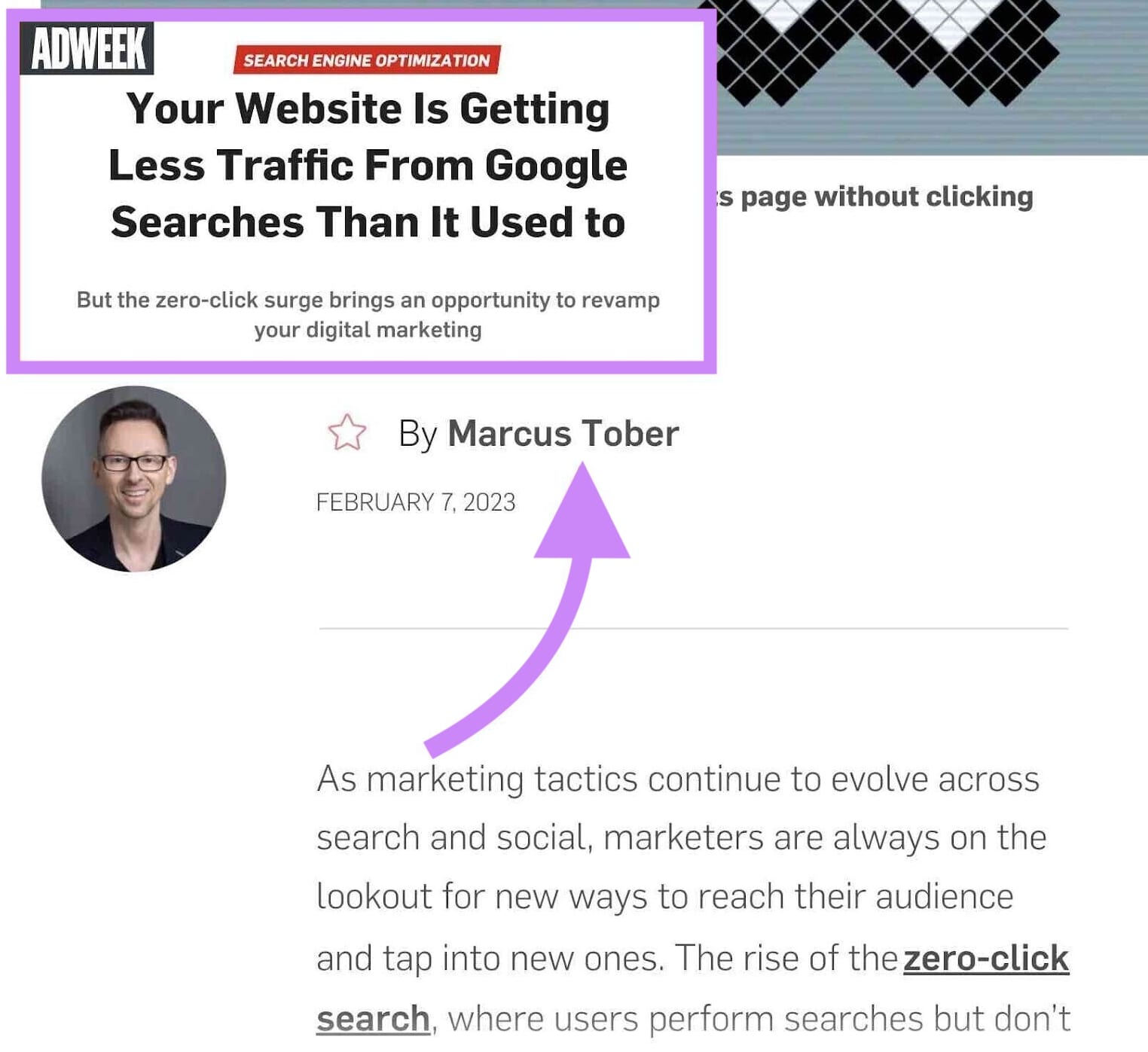
Since AdWeek’s audience is mainly marketers, and so is a portion of Semrush’s audience, the relationship works for both parties.
AdWeek gets insights from an SEO expert, and Semrush (via Marcus) gets its expert in front of AdWeek’s audience.
Digital PR Tools to Run Effective Campaigns
There are a number of tools you can use to make life easier and run effective campaigns.
Tools can help you discover the best opportunities, jump on trending topics, gain contact details, find experts to quote from, and more.
Among them is Semrush’s Media Monitoring tool.
Media Monitoring allows you to track online mentions, discover new backlink opportunities, and keep an eye on a brand’s web presence.
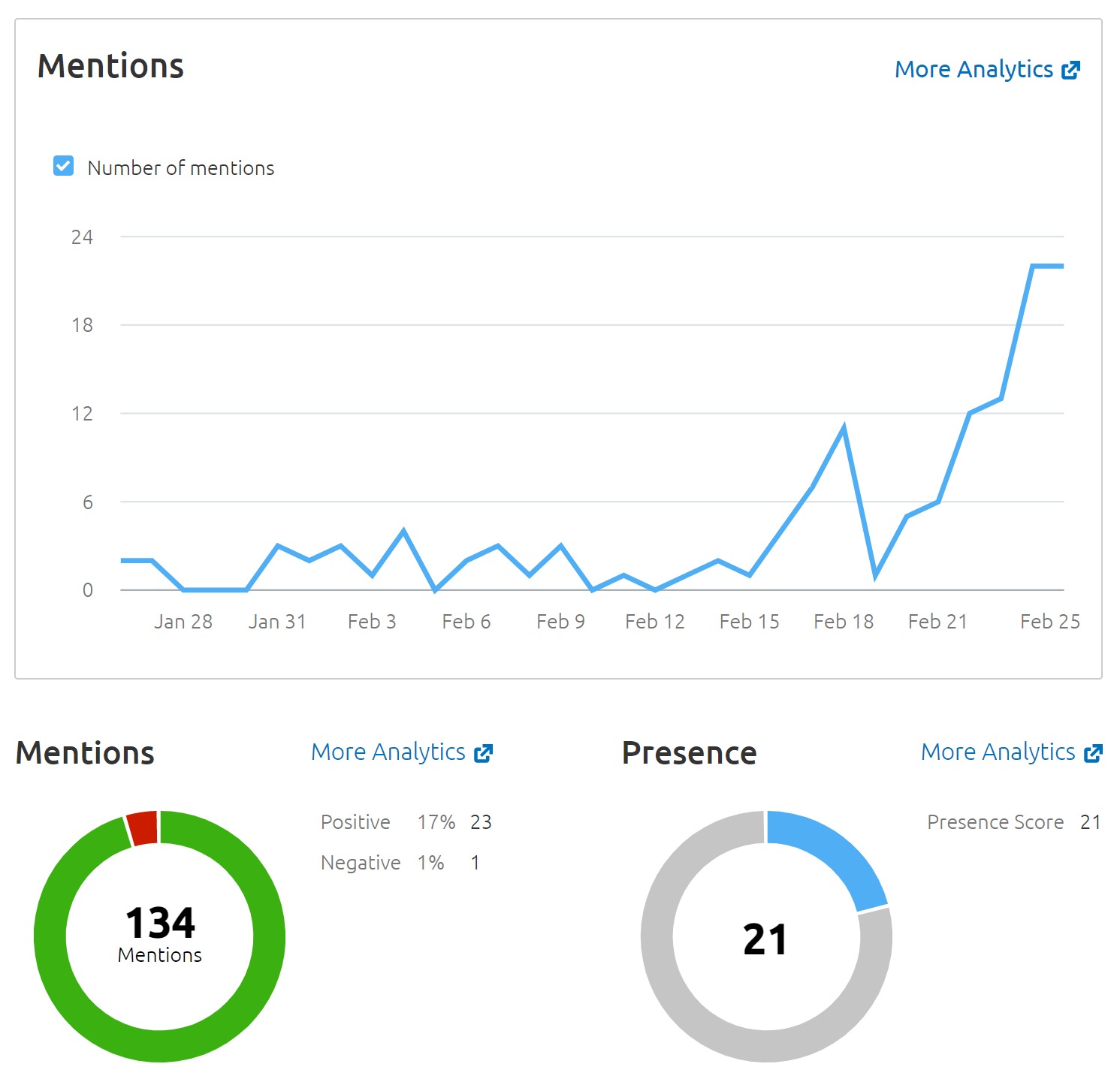
With this information, you can measure your PR efforts, quickly respond to customers, and create targeted strategies to grow your organic presence over time.
Further reading: Learn more about digital PR and link building in our guide: The Ultimate Guide to Digital PR (Plus Tips and Tools)
11. Events
Events are organized occasions that you can host offline or online.
Offline events range from large-scale conferences and exhibitions to smaller-scale initiatives like sample distribution.
Online events include webinars and live broadcasts.
Events provide a unique opportunity for businesses to directly engage with their target audiences, building trust and loyalty.
They offer real-time feedback, product displays, and memorable experiences, setting them apart from other online marketing channels.
For example, wine retail company Nice Drinks held an event with TortillaUK, introducing its new drinks with Tortila’s menu.
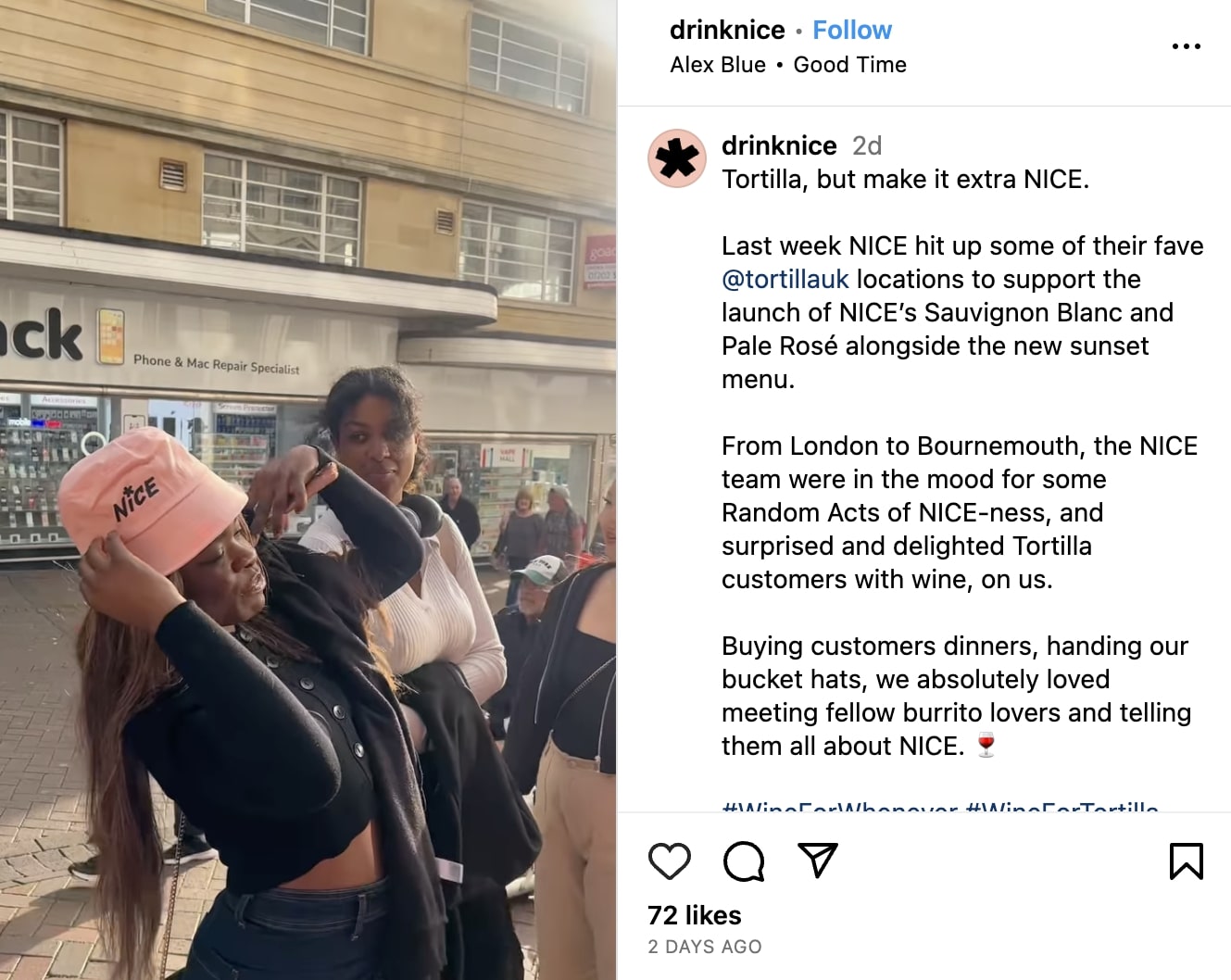
It gifted wine, dinners, and handed out bucket hats to engage burrito lovers. This event fostered brand awareness and deepened customer relationships.
Is there something similar you could do with your product or service to enhance customer relationships?
Tips for Running Events
Running events can be an intensive undertaking. The last thing you want to do is appear disorganized and give your potential customers a poor view of your brand.
Events are about creating positive experiences and building awareness and relationships. So, it’s important to do it right.
Here are our top tips for running a successful event:
- Highlight what makes your event unique and keep your promotional language clear and concise
- If your event is paid, use tiered pricing to incentivize early ticket purchasers
- Partner with influencers who resonate with your target audience for a wider reach
- Send email invitations to your customers and leads
- Announce your event on social media. Use giveaways and countdowns to create pre-event excitement.
- Target niche publications and offer exclusive interviews for added exposure
- Encourage current attendees to refer new ones, possibly with referral discounts
- Use surveys and social proof to improve and market your next event
12. Networking
Networking involves building and maintaining relationships to exchange information, advice, and referrals. It can happen both online and offline:
- Online networking platforms include social media like LinkedIn and virtual meetups
- Offline networking often involves attending conferences and specialized events
Networking is invaluable for building relationships in a way that you can’t replicate with any other marketing channel.
It allows you to build deeper connections with like-minded people who can potentially become your clients. Or introduce you to new opportunities.
For example, eTail West is hosting a specialized event where you can network with ecommerce and retail professionals.
The event will offer thought-provoking sessions and gives you a chance to form relationships with people in the industry.
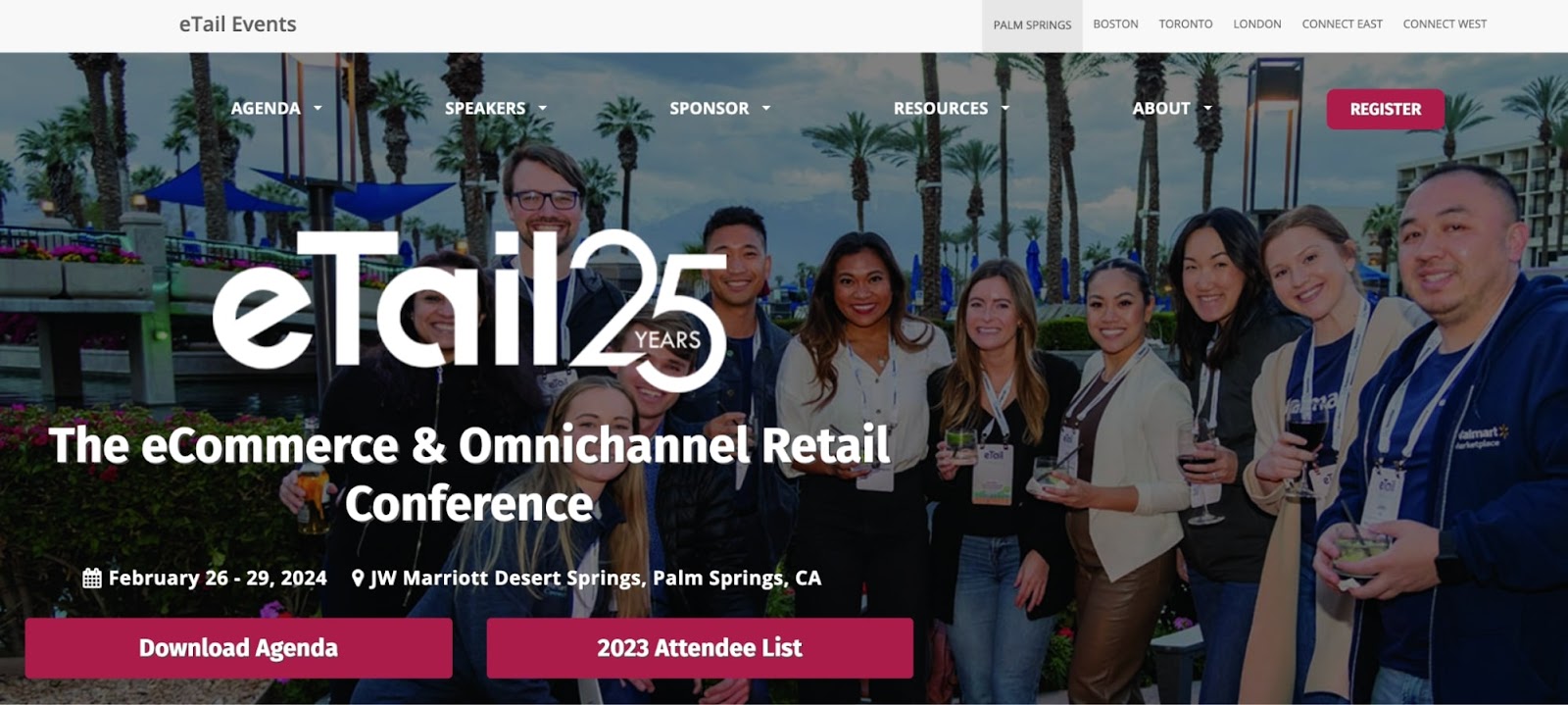
Image Source: eTail
Networking can be a great way to meet new people and learn something new. And there’s something for every industry.
Search “[your industry] + events near me” to find local activities. Or, check out what events industry influencers are attending and explore them as an option.
How to Network Effectively
Networking is one of the oldest marketing channels, but that doesn’t mean it’s easy for everyone. It can take purposeful, proactive care and attention.
Here are our top tips for effective networking:
- Move away from the idea that networking is self-serving. Aim for mutually beneficial relationships where both parties can add value to each other.
- Don’t limit your network to people who are similar to you. Diverse networks offer new perspectives and opportunities.
- Don’t wait until you need something to start networking. Keep your network warm by regularly engaging with your contacts.
- Don’t just collect contacts. Invest your time in building lasting relationships by asking open-ended questions and actually listening to the other person’s stories.
Marketing Channels FAQs
Do you have additional questions about marketing channels? Read these FAQs to learn more.
What Is the Purpose of a Marketing Channel?
A marketing channel connects your business with your target audience. Its purpose is to amplify your message, increase your brand awareness, engage your audience, and ultimately drive sales, all to meet your marketing goals.
How to Choose the Best Marketing Channels
To choose the most effective marketing channels for your business, first, analyze your target audience’s behavior—where do they hang out online, and what content do they consume?
Then, consider your marketing budget and the ROI each channel could offer. This way, you’ll make data-driven decisions that are budget-friendly and impactful.
What’s the Difference Between Multichannel and Omnichannel Marketing?
Multichannel marketing involves using different channels to reach customers, such as email, social media, and physical stores.
However, these channels often operate independently, lacking integration.
Omnichannel marketing takes it a step further by using multiple distribution channels but ensures they work together seamlessly.
For instance, a customer might browse a product on a mobile app, visit a physical store, and then complete the purchase online, with the brand recognizing them across all these touchpoints.
It’s about delivering a unified and consistent experience.
Maximize Your Marketing Channels with Semrush
Finding the perfect marketing channel is essential, no matter who your target audience may be. The right choice depends on your specific business model and goals.
Whatever it is, Semrush has a tool that can help you.
Start your free trial today and optimize your channels for success.
Source link : Semrush.com
